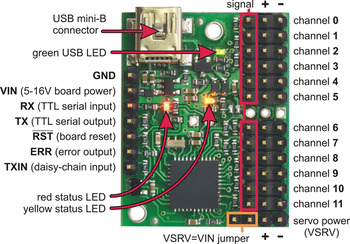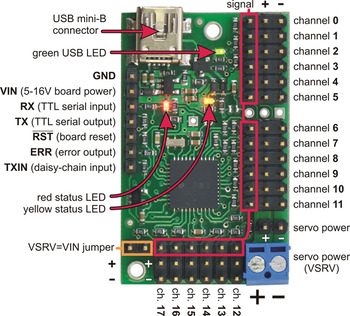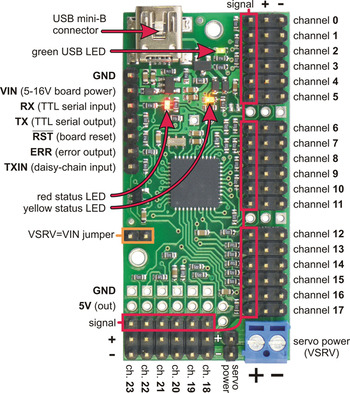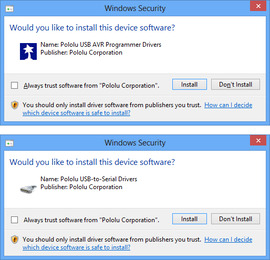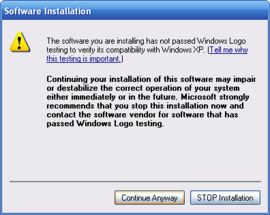Support »
Pololu Maestro Servo Controller User’s Guide
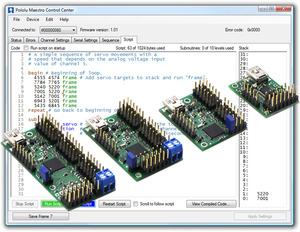
View document on multiple pages.
You can also view this document as a printable PDF.
- 1. Overview
- 2. Contacting Pololu
- 3. Getting Started
- 4. Using the Maestro Control Center
- 5. Serial Interface
- 6. The Maestro Scripting Language
- 7. Wiring Examples
- 8. Writing PC Software to Control the Maestro
- 9. Maestro Settings Limitations
- 10. Related Resources
1. Overview
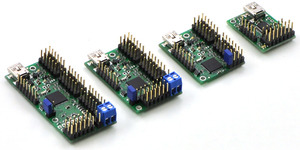 |
The Maestros are Pololu’s second-generation family of USB servo controllers. The Maestro family consists of four controllers, each available fully assembled or as a partial kit:
With three control methods — USB for direct connection to a PC computer, TTL serial for use with embedded systems, and internal scripting for self-contained, host controller-free applications — and channels that can be configured as servo outputs for use with radio control (RC) servos or electronic speed controls (ESCs), digital outputs, or analog/digital inputs, the Maestro is a highly versatile servo controller and general I/O board in a highly compact package. The extremely precise, high-resolution servo pulses have a jitter of less than 200 ns, making the Maestro well suited for high-performance animatronics, and built-in speed and acceleration control make it easy to achieve smooth, seamless movements without requiring the control source to constantly compute and stream intermediate position updates to the Maestro. The Maestro features configurable pulse rates (up to 333 Hz for Mini Maestros) and can generate a wide range of pulses to allow maximum responsiveness and range from modern servos. Units can be daisy-chained with additional Pololu servo and motor controllers on a single serial line.
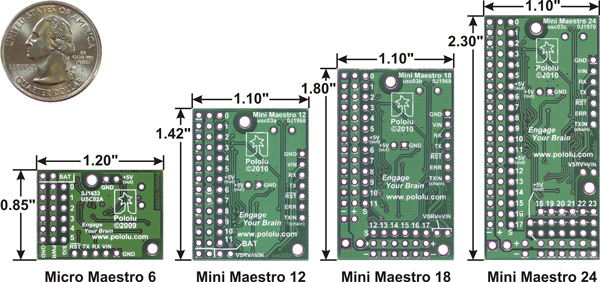 |
A free configuration and control program is available for Windows and Linux (see Section 4), making it simple to configure and test the board over USB, create sequences of servo movements for animatronics or walking robots, and write, step through, and run scripts stored in the servo controller. The Maestro’s internal script memory allows storage of servo positions that can be automatically played back without any computer or external microcontroller connected (see Section 6).
The Maestros’ channels can also be used as general-purpose digital outputs and analog or digital inputs, providing an easy way to read sensors and control peripherals directly from a PC over USB. These inputs can be used with the scripting system to enable creation of self-contained animatronic displays that respond to external stimuli.
A USB A to mini-B cable (not included) is required to connect this device to a computer.
Features
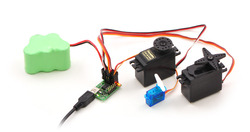 |
- Three control methods: USB, TTL (5 V) serial, and internal scripting
- 0.25μs output pulse width resolution (corresponds to approximately 0.025° for a typical servo, which is beyond what the servo could resolve)
- Configurable pulse rate and wide pulse range (see the Maestro comparison table below)
- Individual speed and acceleration control for each channel
- Channels can be optionally configured to go to a specified position or turn off on startup or error
- Alternate channel functions allow the channels to be used as:
- General-purpose digital outputs (0 or 5 V)
- Analog or digital inputs (channels 0 – 11 can be analog inputs; channels 12+ can be digital inputs)
- One channel can be a PWM output with frequency from 2.93 kHz to 12 MHz and up to 10 bits of resolution (see Section 4.a for details)
- A simple scripting language lets you program the controller to perform complex actions even after its USB and serial connections are removed
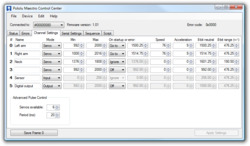 |
The Channel Settings tab in the Maestro Control Center. |
|---|
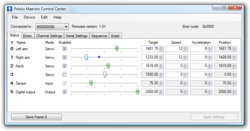 |
The Status tab in the Maestro Control Center. |
|---|
- Free configuration and control application for Windows and Linux makes it easy to:
- Configure and test your controller
- Create, run, and save sequences of servo movements for animatronics and walking robots
- Write, step through, and run scripts stored in the servo controller
- Two ways to write software to control the Maestro from a PC:
- Virtual COM port makes it easy to send serial commands from any development environment that supports serial communication
- Pololu USB Software Development Kit allows use of more advanced native USB commands and includes example code in C#, Visual Basic .NET, and Visual C++
- TTL serial features:
- Supports 300 – 200,000 bps in fixed-baud mode, 300 – 115,200 bps in autodetect-baud mode
- Simultaneously supports the Pololu protocol, which gives access to advanced functionality, and the simpler Scott Edwards MiniSSC II protocol (there is no need to configure the device for a particular protocol mode)
- Can be daisy-chained with other Pololu servo and motor controllers using a single serial transmit line
- Chain input allows reception of data from multiple Mini Maestros using a single serial receive line without extra components (does not apply to Micro Maestros)
- Can function as a general-purpose USB-to-TTL serial adapter for projects controlled from a PC
- Board can be powered off of USB or a 5 – 16 V battery, and it makes the regulated 5V available to the user
- Upgradable firmware
Maestro Comparison Table
 |
 |
 |
 |
|
|---|---|---|---|---|
| Micro Maestro | Mini Maestro 12 | Mini Maestro 18 | Mini Maestro 24 | |
| Channels: | 6 | 12 | 18 | 24 |
| Analog input channels: | 6 | 12 | 12 | 12 |
| Digital input channels: | 0 | 0 | 6 | 12 |
| Width: | 0.85" (2.16 cm) | 1.10" (2.79 cm) | 1.10" (2.79 cm) | 1.10" (2.79 cm) |
| Length: | 1.20" (3.05 cm) | 1.42" (3.61 cm) | 1.80" (4.57 cm) | 2.30" (5.84 cm) |
| Weight(1): | 3.0 g | 4.2 g | 4.9 g | 6.0 g |
| Configurable pulse rate(2): | 33–100 Hz | 1–333 Hz | 1–333 Hz | 1–333 Hz |
| Pulse range(2): | 64–3280 μs | 64–4080 μs | 64–4080 μs | 64–4080 μs |
| Script size(3): | 1 KB | 8 KB | 8 KB | 8 KB |
1 This is the weight of the board without header pins or terminal blocks.
2 The available pulse rate and range depend on each other and factors such as baud rate and number of channels used. See Section 9 for details.
3 The user script system is more powerful on the Mini Maestro than on the Micro Maestro. See Section 6.d for details.
Application Examples
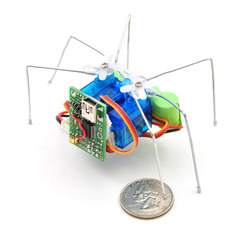 |
Micro Maestro as the brains of a tiny hexapod robot. |
|---|
- Serial servo controller for multi-servo projects (e.g. robot arms, animatronics, fun-house displays) based on microcontroller boards such as the BASIC Stamp, Orangutan robot controllers, or Arduino platforms
- Computer-based servo control over USB port
- Computer interface for sensors and other electronics:
- Read a gyro or accelerometer from a computer for novel user interfaces
- Control a string of ShiftBrites from a computer for mood lighting
- General I/O expansion for microcontroller projects
- Programmable, self-contained Halloween or Christmas display controller that responds to sensors
- Self-contained servo tester
1.a. Micro Maestro Pinout and Components
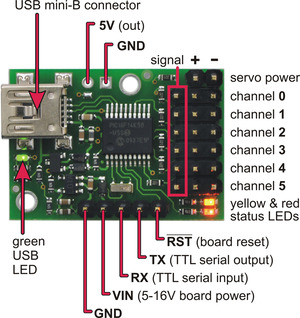 |
Micro Maestro 6-channel USB servo controller (fully assembled) labeled top view. |
|---|
Note: This section applies to the Micro Maestro servo controller. Please see Section 1.b for Mini Maestro pinout and component information.
The Pololu Micro Maestro 6-channel servo controller can connect to a computer’s USB port via a USB A to mini-B cable (not included). The USB connection is used to configure the servo controller. It can also be used to send commands to the servo controller, get information about the servo controller’s current state, and send and receive TTL serial bytes on the TX and RX lines.
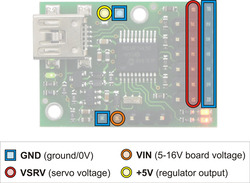 |
Micro Maestro power pins. |
|---|
The processor and the servos can have separate power supplies.
Processor power must come either from USB or from an external 5–16V power supply connected to the VIN and GND inputs. It is safe to have an external power supply connected at the same time that USB is connected; in such cases the processor will be powered from the external supply. Note that if the external supply falls below 5 V, correct operation is not guaranteed, even if USB is also connected.
Servo power connections are provided in the upper right corner of the Micro Maestro board. Servo power is passed directly to the servos without going through a regulator, so the only restrictions on your servo power supply are that it must be within the operating range of your servos and provide enough current for your application. Please consult the datasheets for your servos to determine an appropriate servo power source, and note that a ballpark figure for the current draw of an average straining servo is 1 A.
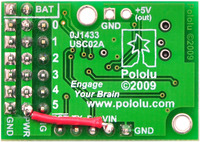 |
Micro Maestro configured to use a single power supply for both board and servos. |
|---|
You can power the Maestro’s processor and servos from a single power supply by connecting the positive power line to both VIN and the servo power ports. An easy way to accomplish this on the Micro Maestro is to solder a wire on the bottom of the board between VIN and one of the servo power connections as shown in the picture to the right. Only one ground connection is needed because all ground pins on the board are connected.
The 5V (out) power output allows you to power your own 5V devices from the on-board 50mA regulator or directly from USB. The on-board regulator is used whenever VIN is powered; in this case, since the Maestro requires 30 mA, there is about 20 mA available to power other devices.
The SIG lines (0, 1, 2, …) are used for sending pulses to servos, controlling digital outputs, and measuring analog voltages. These lines are protected by 220Ω resistors. The total current limit (in or out) for these pins is 60 mA, but when using the on-board regulator the current out is limited to 20 mA (see above.)
The RX line is used to receive non-inverted TTL (0–5 V) serial bytes, such as those from microcontroller UARTs. These bytes can either be serial commands for the Maestro, arbitrary bytes to send back to the computer via the USB connection, or both. For more information about the Maestro’s serial interface, see Section 5.a. Note that the Maestro will probably be able to receive 3.3V TTL serial bytes, but it is not guaranteed to read 3.3V as high on the RX pin, so you should boost 3.3V TTL serial signals to above 4V if you want to ensure reliable operation.
The TX line transmits non-inverted TTL (0–5 V) serial bytes. These bytes can either be responses to serial commands sent to the Maestro, or arbitrary bytes sent from the computer via the USB connection.
The RST pin can be driven low to reset the Maestro’s microcontroller, but this should not be necessary for typical applications. The line is internally pulled high, so it is safe to leave this pin unconnected. Driving RST low is roughly equivalent to powering off the Maestro; it will not reset any of the configuration parameters stored in non-volatile memory. To reset the configuration parameters, select Device > Reset to default settings… in the Maestro Control Center.
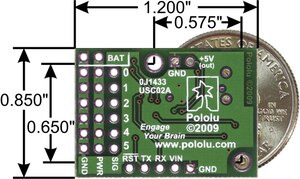 |
Micro Maestro 6-channel USB servo controller bottom view with quarter for size reference. |
|---|
The dimensions of the Micro Maestro PCB are 1.2″ × 0.85″. The mounting holes have a diameter of 0.086″and are intended for #2 or M2 screws. The vertical and horizontal distances between the two mounting holes are 0.65″ and 0.575″. The Micro Maestro weighs 3.0 g (0.11 oz) without header pins.
1.b. Mini Maestro Pinout and Components
|
|
|
Note: This section applies to the Mini Maestro 12, 18, and 24 servo controllers. Please see Section 1.a for Micro Maestro pinout and component information.
The Pololu Mini Maestro 12-,18-, and 24-channel servo controllers can connect to a computer’s USB port via a USB A to mini-B cable (not included). The USB connection is used to configure the servo controller. It can also be used to send commands to the servo controller, get information about the servo controller’s current state, and send and receive TTL serial bytes on the TX and RX lines.
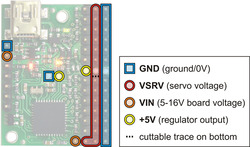 |
Mini Maestro 12 power pins. |
|---|
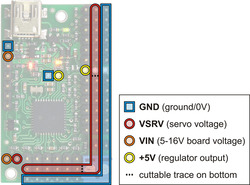 |
Mini Maestro 18 power pins. |
|---|
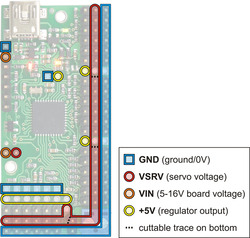 |
Mini Maestro 24 power pins. |
|---|
The processor and the servos can have separate power supplies.
Processor power must come either from USB or from an external 5–16V power supply connected to the VIN and GND inputs on the left side of the board. It is safe to have an external power supply connected at the same time that USB is connected; in that case the processor will be powered from the external supply. Note that if the external supply falls below 5 V, correct operation is not guaranteed, even if USB is also connected.
Servo power connections are provided in the lower right corner of the Mini Maestro board. On the Mini Maestro 18 and 24, you can make servo power connections via a 2-pin terminal block or a 2-pin 0.1″ header; the Mini Maestro 12 only has a 2-pin 0.1″ header for connecting servo power. Servo power is passed directly to the servos without going through a regulator, so the only restrictions on your servo power supply are that it must be within the operating range of your servos and provide enough current for your application. Please consult the datasheets for your servos to determine an appropriate servo power source, and note that a ballpark figure for the current draw of an average straining servo is 1 A.
You can power the Maestro’s processor and servos from a single power supply by connecting the positive power line to both VIN and the servo power ports (only one ground connection is needed because all ground pins on the board are connected). The recommended way to do this is to connect your power supply to the dedicated servo power pins in the corner of the board and use the included blue shorting block to connect the pins labeled “VSRV=VIN”.
The 5V (out) power output allows you to power your own 5V devices from the 100mA on-board regulator or directly from USB. The on-board regulator is used whenever VIN is powered; in this case, since the Maestro requires 50 mA, there is about 50 mA available to power other devices.
The signal lines (0, 1, 2, …) are used for sending pulses to servos, controlling digital outputs, and measuring voltages. The total current limit (in or out) for these pins is 200 mA, but when using the on-board regulator the current out is limited to 50 mA (see above.)
The RX line is used to receive non-inverted TTL (0–5 V) serial bytes, such as those from microcontroller UARTs. These bytes can either be serial commands for the Maestro, arbitrary bytes to send back to the computer via the USB connection, or both. For more information about the Maestro’s serial interface, see Section 5.a. Note that the Maestro will probably be able to receive 3.3V TTL serial bytes, but it is not guaranteed to read 3.3V as high on the RX pin, so you should boost 3.3V TTL serial signals to above 4V if you want to ensure reliable operation.
The TX line transmits non-inverted TTL (0–5 V) serial bytes. These bytes are either generated by the Mini Maestro itself (as responses to serial commands or arbitrary bytes sent from the computer via the USB connection), or they come from the TXIN line.
The RST pin can be driven low to reset the Maestro’s microcontroller, but this should not be necessary for typical applications. The line is internally pulled high, so it is safe to leave this pin unconnected. Driving RST low is roughly equivalent to powering off the Maestro; it will not reset any of the configuration parameters stored in non-volatile memory. To reset the configuration parameters, select Device > Reset to default settings… in the Maestro Control Center.
The ERR line is an output that is tied to the red error/user LED. It is driven high when the red LED is on, and it is a pulled low through the red LED when the red LED is off. The red LED turns on when an error occurs, turns off when the error flags have been cleared, and can also be controlled by the user script. Since the ERR line is never driven low, it is safe to connect the ERR line of multiple Mini Maestros together. Please note, however, that doing this will cause the red LEDs of all connected Mini Maestros to turn on whenever one of the Mini Maestros turns on its red LED. For more information on the possible error conditions and response options, please see Section 4.e.
The TXIN line is a serial input line that makes it easy to chain together multiple Mini Maestros. Any serial bytes received on this line will be buffered through an AND gate and transmitted on the TX line. See Section 5.g for more information about daisy chaining.
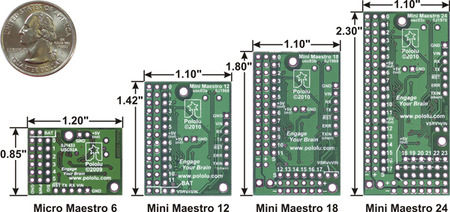 |
Bottom view with dimensions (in inches) of Pololu Micro and Mini Maestro servo controllers. |
|---|
The dimensions of the Mini Maestro PCBs are shown in the picture above, along with the Micro Maestro for comparison. The mounting holes have a diameter of 0.086″and are intended for #2 or M2 screws. The vertical and horizontal distances between the two mounting holes are as follows: 1.2″ and 0.5″ for the Mini Maestro 12, 1.58″ and 0.5″ for the Mini Maestro 18, and 1.5″ and 0.5″ for the Mini Maestro 24.
1.c. Indicator LEDs
The Maestro has three indicator LEDs:
- The green USB LED indicates the USB status of the device. When the Maestro is not connected to a computer via the USB cable, the green LED will be off. When you connect the Maestro to USB, the green LED will start blinking slowly. The blinking continues until the Maestro receives a particular message from the computer indicating that the Maestro’s USB drivers are installed correctly. After the Maestro gets this message, the green LED will be on, but it will flicker briefly when there is USB activity. The control center application constantly streams data from the Maestro, so when the control center is running and connected to the Maestro, the green LED will flicker constantly.
- The red error/user LED usually indicates an error. The red LED turns on when an error occurs, and turns off when the error flags have been cleared. See Section 4.e for more information about errors. The red LED can also be controlled by the user script; the red LED will be on if there is an error or if the script command for turning it on was run.
- The yellow status LED indicates the control status. When the Maestro is in auto-baud detect mode (the default) and has not yet detected the baud rate, the yellow LED will blink slowly. During this time the Maestro does not transmit any servo pulses. Once the Maestro is ready to drive servos, the yellow LED will periodically flash briefly. The frequency of the flashes is proportional to the servo period (the amount of time between pulses on a single channel); with a period of 20 ms the flashing occurs approximately once per second. The number of flashes indicates the state: a single flash indicates that none of the servos are enabled (no pulses are being sent) and all output channels are low, while a double flash indicates that at least one of the servos is enabled or one of the output channels is being driven high. Also, when a valid serial command is received, the yellow LED will emit a brief, dim flash which ends when the next valid serial command is received or when the main blinking occurs (whichever happens first). Mini Maestros with firmware version 1.00 only emit single flashes unless a servo channel with a speed or acceleration limit is enabled. This behavior was fixed in firmware version 1.02 to be consistent with the Micro Maestro.
When the Maestro is reset in some other way than being initially powered up, the red and/or yellow LEDs blink four times to indicate the reset condition:
- Yellow off, red blinking: A brownout reset. This occurs when the Maestro’s 5 V line drops below about 3.0 V, usually due to low batteries or an inadequate power supply.
- Yellow blinking, red off: The Maestro was reset by a low voltage on its RST line.
- Yellow and red blinking together: A firmware crash resulted in a “watchdog” reset. This also occurs immediately following a firmware upgrade, as a normal part of the upgrade process.
- Yellow blinking, red steady: A firmware error resulted in a soft reset. This should never occur during normal usage.
1.d. Supported Operating Systems
The Maestro USB drivers and configuration software work under Microsoft Windows XP, Windows Vista, Windows 7, Windows 8, Windows 8.1, Windows 10, Windows 11, and Linux.
On ARM-based Linux machines such as the Raspberry Pi, the Maestro’s graphical configuration program (the Maestro Control Center) does not work. This is caused by problems with Mono’s implementations of WinForms on those systems.
We do not provide any software for macOS, but the Maestro’s two virtual serial ports are compatible with macOS 10.7 (Lion) and later. The Maestro must be initially configured from a Windows or Linux computer, but after that it can be controlled from a Mac. If you have macOS 10.11 or later, you will need to update your Maestro’s firmware to version 1.03 or later to use the Maestro’s virtual serial ports (see Section 4.f).
2. Contacting Pololu
You can check the product page of your particular Maestro model for additional information. We would be delighted to hear from you about any of your projects and about your experience with the Maestro. You can contact us directly or post on our forum. Tell us what we did well, what we could improve, what you would like to see in the future, or anything else you would like to say!
3. Getting Started
3.a. Installing Windows Drivers and Software
If you are using Windows XP, you will need to have Service Pack 3 installed before installing the drivers for the Maestro. See below for details.
Before you connect your Maestro to a computer running Microsoft Windows, you should install its drivers:
- Download the Maestro Servo Controller Windows Drivers and Software (5MB zip)
- Open the ZIP archive and run setup.exe. The installer will guide you through the steps required to install the Maestro Control Center, the Maestro command-line utility (UscCmd), and the Maestro drivers on your computer. If the installer fails, you might have to extract all the files to a temporary directory, right click setup.exe, and select “Run as administrator”.
- During the installation, Windows will ask you if you want to install the drivers. Click “Install” (Windows Vista, Windows 7, and later) or “Continue Anyway” (Windows XP).
|
|
- After the installation is finished, your start menu should have a shortcut to the Maestro Control Center (in the Pololu folder). This is a Windows application that allows you to configure, control, debug, and get real-time feedback from the Maestro. There will also be a command-line utility called UscCmd which you can run at a Command Prompt.
Windows 10, Windows 8, Windows 7, and Windows Vista users: After following the steps above, you can connect a Maestro to your computer, and your computer should automatically install the necessary drivers. No further action from you is required.
Windows XP users: After following the steps above, follow steps 5 through 9 below for each new Maestro you connect to your computer.
- Connect the device to your computer’s USB port. The Maestro shows up as three devices in one so your XP computer will detect all three of those new devices and display the “Found New Hardware Wizard” three times. Each time the “Found New Hardware Wizard” pops up, follow steps 6-9.
- When the “Found New Hardware Wizard” is displayed, select “No, not this time” and click “Next”.
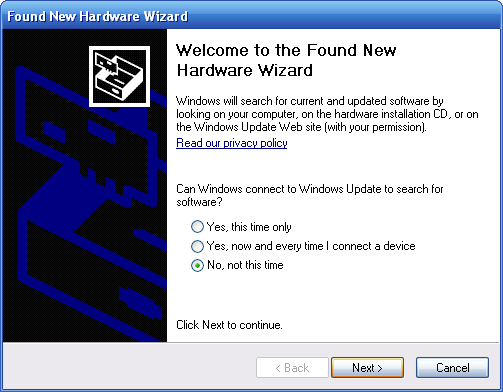 |
- On the second screen of the “Found New Hardware Wizard”, select “Install the software automatically” and click “Next”.
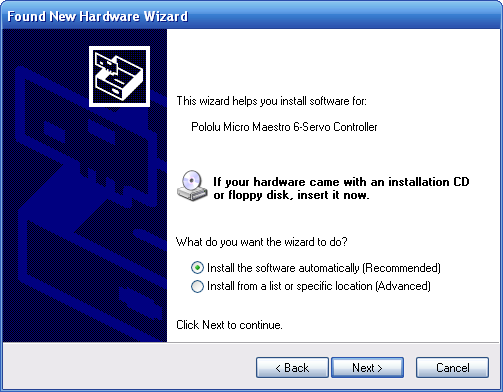 |
- Windows XP will warn you again that the driver has not been tested by Microsoft and recommend that you stop the installation. Click “Continue Anyway”.
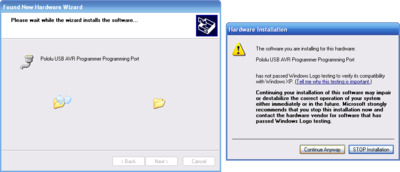 |
- When you have finished the “Found New Hardware Wizard”, click “Finish”. After that, another wizard will pop up. You will see a total of three wizards when plugging in the Maestro. Follow steps 6-9 for each wizard.
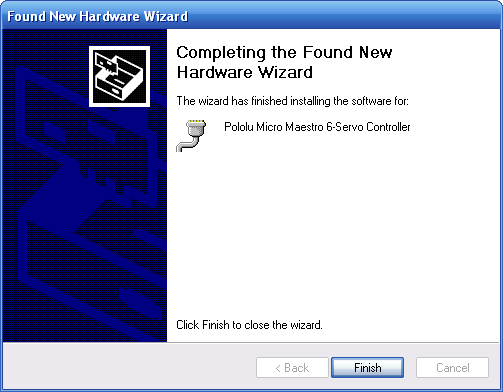 |
After installing the drivers and plugging the Maestro in via USB, if you go to your computer’s Device Manager, you should see three entries for the Maestro that look like what is shown below:
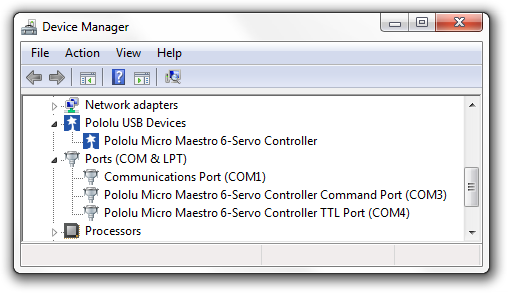 |
Windows 7 device manager showing the Micro Maestro 6-channel USB servo controller. |
|---|
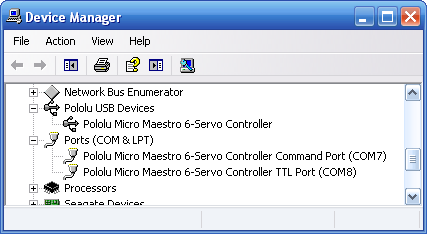 |
Windows XP device manager showing the Micro Maestro 6-channel USB servo controller. |
|---|
COM ports
After installing the drivers, if you go to your computer’s Device Manager and expand the “Ports (COM & LPT)” list, you should see two COM ports for the Maestro: the Command Port and the TTL Port. In parentheses after these names, you will see the name of the port (e.g. “COM5” or “COM6”).
You might see that the COM ports are named “USB Serial Device” in the Device Manager instead of having descriptive names. This can happen if you are using Windows 10 or later and you plugged the Maestro into your computer before installing our drivers for it. In that case, Windows will set up your Maestro using the default Windows serial driver (usbser.inf), and it will display “USB Serial Device” as the name for each port. The ports will be usable, but it will be hard to distinguish the ports from each other because of the generic name shown in the Device Manager. We recommend fixing the names in the Device Manager by right-clicking on each “USB Serial Device” entry, selecting “Update Driver Software…”, and then selecting “Search automatically for updated driver software”. Windows should find the Maestro drivers you already installed, which contain the correct name for the port.
If you want to change the COM port number assigned to your USB device, you can do so using the Device Manager. Bring up the properties dialog for the COM port and click the “Advanced…” button in the “Port Settings” tab. From this dialog you can change the COM port assigned to your device.
If you use Windows XP and experience problems installing or using the serial port drivers, the cause of your problems might be a bug in older versions of Microsoft’s usb-to-serial driver usbser.sys. Versions of this driver prior to version 5.1.2600.2930 will not work with the Maestro. You can check what version of this driver you have by looking in the “Details” tab of the “Properties” window for usbser.sys in C:\Windows\System32\drivers_. To get the fixed version of the driver, you will need to install Service Pack 33. If you do not want Service Pack 3, you can try installing Hotfix KB918365 instead, but some users have had problems with the hotfix that were resolved by upgrading to Service Pack 3. The configuration software will work even if the serial port drivers are not installed properly.
Native USB interface
There should be an entry for the Maestro in the “Pololu USB Devices” category of the Device Manager. This represents the Maestro’s native USB interface, and it is used by our configuration software.
3.b. Installing Linux Drivers and Software
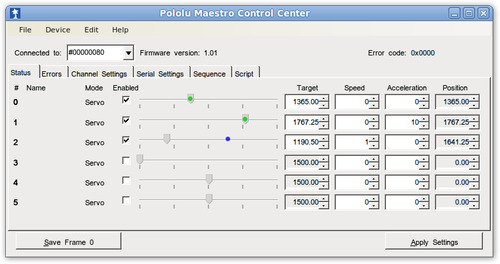 |
The Maestro Control Center running in Ubuntu Linux. |
|---|
You can download the Maestro Control Center and the Maestro command-line utility (UscCmd) for Linux here:
- Maestro Servo Controller Linux Software (126k gz)
Unzip the tar/gzip archive by running “tar -xzvf” followed by the name of the file. After following the instructions in README.txt, you can run the programs by executing MaestroControlCenter and UscCmd.
You can also download the C# source code of UscCmd as part of the Pololu USB Software Development Kit. Read README.txt in the SDK for more information.
The Maestro’s two virtual serial ports can be used in Linux without any special driver installation. The virtual serial ports are managed by the cdc-acm kernel module, whose source code you can find in your kernel’s source code drivers/usb/class/cdc-acm.c. When you connect the Maestro to the PC, the two virtual serial ports should appear as devices with names like /dev/ttyACM0 and /dev/ttyACM1 (the number depends on how many other ACM devices you have plugged in). The port with the lower number should be the Command Port, while the port with the higher number should be the TTL Serial Port. You can use any terminal program (such as kermit) to send and receive bytes on those ports.
3.c. Using the Maestro without USB
It is possible to use the Maestro as a serial servo controller without installing any USB drivers or using a PC. Without using USB, you will not be able to change the Maestro’s settings, but you can use the default settings which are suitable for many applications. The default settings that the Maestro ships with are described below.
Default Settings
- The serial mode is “UART, detect baud rate”; after you send the 0xAA baud rate indication byte, the Maestro will accept TTL-level serial commands on the RX line.
- The Pololu Protocol device number is 12, the Mini SSC offset is 0, and serial timeout and CRC are disabled.
- All channels are configured as servos, with a minimum pulse width of 992 μs and a maximum pulse width of 2000 μs.
- The 8-bit neutral point is 1500 μs and the 8-bit range is 476.25 μs.
- On startup or error, the servos turn off (no pulses are sent).
- On startup, there are no speed or acceleration limits, but you can set speed and acceleration limits using serial commands.
- The servo period is 20 ms (each servo receives a pulse every 20 ms).
- The user script is empty.
4. Using the Maestro Control Center
The Maestro’s USB interface provides access to all configuration options as well as support for real-time control, feedback, and debugging. The Maestro Control Center is a graphical tool that makes it easy for you to use the USB interface; for almost any project, you will want to start by using the control center to set up and test your Maestro. This section explains most of the features of the Maestro and the Maestro Control Center.
4.a. Status and Real-time Control
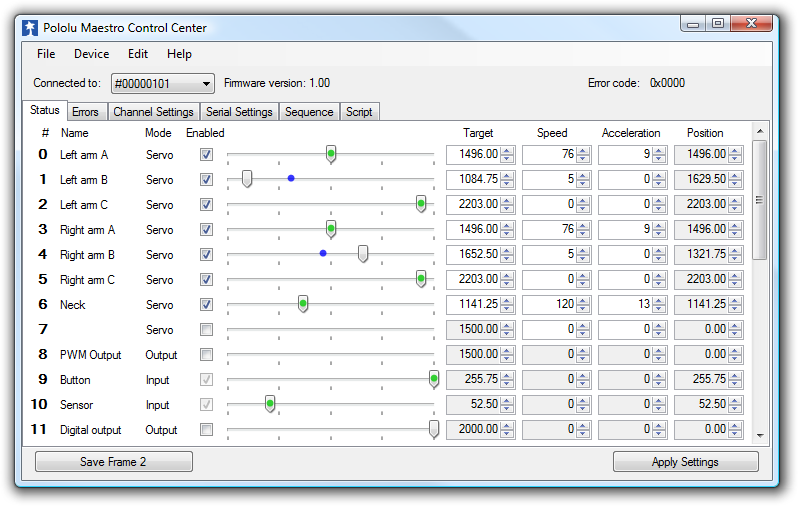 |
The Status tab in the Maestro Control Center. |
|---|
The Status tab is used for controlling the Maestro’s outputs and for monitoring its status in real time. A separate row of controls is displayed for each of the Maestro’s channels. In the screenshot above, there are 12 channels displayed because the Maestro Control Center is connected to the Mini Maestro 12-channel servo controller. When the Maestro Control Center connects to Maestro models with more or fewer channels, it displays more or fewer channels on the screen.
For a channel configured as a servo or output, the checkbox enables the output, dragging the slider adjusts the target setting of the channel, and the green ball indicates the channel’s current position. For example, if the channel is set to a relatively slow speed, when the slider is moved to a new position, the green ball will slowly move until it has reached the slider, indicating that the output has reached its target. For more precise control, a target value may also be entered directly into the “Target” input box. The slider is automatically scaled to match the minimum and maximum values specified in the Channel Settings tab, which is described in Section 4.b.
For a channel configured as input, the slider, green ball, “Target”, and “Position” display the current value of the input. There is no control available for inputs. The inputs on channels 0–11 are analog: their values range from 0 to 255.75, representing voltages from 0 to 5 V. The inputs on channels 12–23 are digital: their values are either exactly 0 or exactly 255.75.
The “Speed” and “Acceleration” inputs allow the speed and acceleration of individual servo channels to be adjusted in real time. The default values are specified in the Channel Settings tab, but it can be useful to adjust them here for fine-tuning.
All of the controls on this tab always display the current values as reported by the Maestro itself, so they are useful for monitoring the actions caused by another program or device. For example, if a microcontroller uses the TTL serial interface to change the speed of servo channel 2 to a value of 10, this value will be displayed immediately in the corresponding input, even if something else was formerly entered there.
PWM Output (Mini Maestro 12, 18, and 24 only)
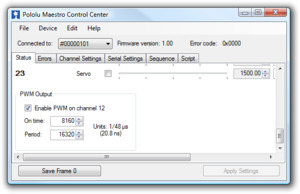 |
The PWM Output control in the Status tab in the Maestro Control Center (only available on the Mini Maestro 12, 18, and 24). |
|---|
On the Mini Maestro 12, 18, and 24, one of the channels may be used as a general-purpose PWM output with a frequency from 2.93 kHz to 12 MHz and up to 10 bits of resolution. This could be used, for example, as an input to a motor driver or for LED brightness control. The PWM output is on channel 8 for the Mini Maestro 12 and on channel 12 for the Mini Maestro 18 and 24. This channel must be configured as an output for PWM to be available.
You may use the PWM Output control at the bottom of the Status tab to test out PWM, by checking the checkbox and entering specific values for the on time and period, in units of 1/48 μs. A period of 4800, for example, will generate a frequency of 10 kHz. The resolution on these values depends on the period as shown in the table below:
| Period range |
Period resolution |
On-time resolution |
|---|---|---|
| 1–1024 | 4 | 1 |
| 1025–4096 | 16 | 4 |
| 4097–16384 | 64 | 16 |
The special periods 1024, 4096, and 16384 are not recommended, since 100% duty cycle is not available at these values. If the on time is set equal to the period at one of the special values, the duty cycle will be 0% (a low output). The periods 1020 (47.1 kHz), 4080 (11.7 kHz), and 16320 (2.9 kHz) provide the best possible resolution with 100% and 0% duty cycle options, so you should use one of these periods if possible.
You will probably want to use serial commands or a script to make use of PWM in your project. See Section 5.e and Section 6.b for more information.
4.b. Channel Settings
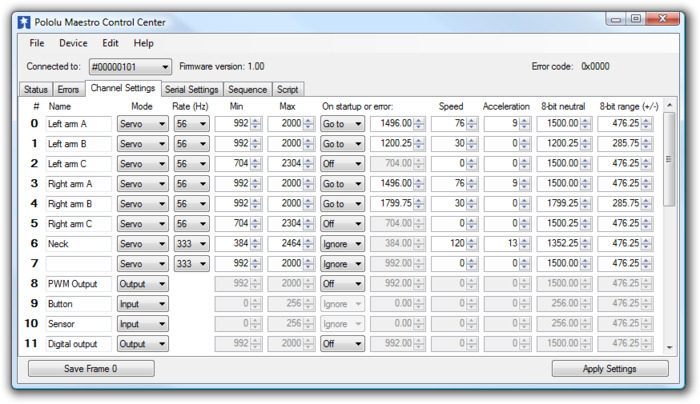 |
The Channel Settings tab in the Maestro Control Center. |
|---|
The Channel Settings tab contains controls for many of the channel-related parameters that are stored on the Maestro, affecting its operation immediately on start-up.
A separate row of controls is displayed for each of the Maestro’s channels:
Name. Each of the channels may be assigned a name, for your convenience. Channel names are not stored on the device but instead in the system registry on your computer; if you want to use your Maestro on a different computer without losing the names, save a settings file on the old computer and load it into the Maestro with the new one.
Mode. The mode of the channel is the most basic setting determining its operation. There are three options:
- Servo (the default) indicates an R/C servo PWM output.
- Input specifies that the channel should be used as an analog or digital input. The inputs on channels 0–11 are analog: they are measured continuously as a value between 0 and 1023 (VCC), at a maximum rate of about 20 kHz. The inputs on channels 12–23 are digital: their values are either exactly 0 or exactly 1023. Note that the values displayed in the Target and Position boxes in the Status tab are one quarter of the actual input value, so 1023 is displayed as 255.75.
- Output specifies that the channel should be used as a simple digital output. Instead of indicating a pulse width, the position value of the channel is used to control whether the output is low (0 V) or high (VCC). Specifically, the output is low unless the position value is greater than or equal to 1500.00 μs.
Rate specifies the pulse rate for each Servo channel. On the Micro Maestro 6, all servos must have the same pulse rate, while on the Mini Maestro 12, 18, an 24, you can have two different rates and choose which rate to use on each channel. The pulse rates available are controlled by the Period and Period multiplier settings described below.
Min and Max specify the allowed values for the channel’s position. For channels configured as Servo outputs, the Min and Max settings correspond respectively to the minimum and maximum allowed pulse widths for the servo, in units of microseconds.
On startup or error. This option specifies what value the target of the channel should have when the device starts up (power-up or reset) or when there is an error. Note that if there is a speed or acceleration setting for the channel, the output will smoothly transition to the specified position on an error, but not during start-up, since it has no information about the previous position of the servo in this case.
- Off specifies that the servo should initially be off (have a value of 0), and that it should be turned off whenever an error occurs.
- Ignore specifies that the servo should initially be off, but that its value should not change on error.
- Go to specifies a default position for the servo. The servo target will be set to this position on start-up or when an error occurs.
Speed. This option specifies the speed of the servo in units of 0.25 μs / (10 ms). For example, with a speed of 4, the position will change by at most 1 μs per 10 ms, or 100.00 μs/s. Mini Maestro 12, 18, and 24 only: If you use a period other than the default 20 ms, the units of speed are different. See below for more information.
Acceleration. This option specifies the acceleration of the servo in units of (0.25 μs) / (10 ms) / (80 ms). For example, with an acceleration of 4, the speed of the servo will change by a maximum of 1250 μs/s every second. Mini Maestro 12, 18, and 24 only: If you use a period other than the default 20 ms, the units of acceleration are different. See below for more information.
8-bit neutral. This option specifies the target value, in microseconds, that corresponds to 127 (neutral) for 8-bit commands.
8-bit range. This option specifies the range of target values accesible with 8-bit commands. An 8-bit value of 0 results in a target of neutral – range, while an 8-bit value of 254 results in a target value of neutral + range.
Advanced pulse control options are available:
Period is an advanced option that sets the period of all of the servo pulses, in milliseconds. This is the amount of time between successive pulses on a given channel. If you are unsure about this option, leave it at the default of 20 ms. Mini Maestro 12, 18, and 24 only: the units of speed and acceleration depend on the pulse rate. The units depend only on Period, not on Period multiplier. Please refer to the following table for the relationship between Period and speed/acceleration units:
| Period (T) | Rate | Speed units | Acceleration units |
|---|---|---|---|
| T = 20 ms | 50 Hz | (0.25 μs)/(10 ms) | (0.25 μs)/(10 ms)/(80 ms) |
| T = 3–19 ms | > 50 Hz | (0.25 μs)/T | (0.25 μs)/T/(8T) |
| T > 20 ms | < 50 Hz | (0.25 μs)/(T/2) | (0.25 μs)/(T/2)/(4T) |
Servos available is an advanced option for the Micro Maestro only specifying the number of channels that may be used to control servos. For example, if this value is set to 4, only the channels 0–3 will be available as servo channels. The other channels must all be set to Input or Output. The only reasons to make fewer servos available are to allow a longer maximum pulse length or a shorter period.
Period multiplier is an advanced option for the Mini Maestro 12, 18, and 24 that allows a larger period (lower pulse rate) on some of the channels. For example, if you select a period of 3 and a multiplier of 6, you can have some servos run at 3 ms (333 Hz) and the others at 18 ms (55 Hz). When the multiplier is greater than 1, the pulse rate options will be shown in each channel in the Rate column.
For the Mini Maestro 24-channel servo controller, one extra option is available:
Enable pull-ups on channels 18-20 turns on pull-up resistors for all of the channels 18-20 that are configured as inputs. This guarantees that the input value will be high when nothing else is driving the line. When enabled, this feature allows you to connect buttons or switches to channels 18, 19, or 20 without supplying your own external pull-up resistor: simply connect the button/switch between ground and signal line.
4.c. Sequencer
 |
The Sequence tab in the Maestro Control Center. |
|---|
The Sequence tab allows simple motion sequences to be created and played back on the Maestro. A sequence is simply a list of “frames” specifying the positions of each of the servos and a duration (in milliseconds) for each frame. In version 1.6.0.0 and later of the software, each frame of a sequence also contains speed and acceleration values for each servo, but these values are not used by default (see the “Speed and acceleration” subsection below). Sequences are stored in the registry of the computer where the sequence was created. Sequences can be copied to the script, which is saved on the Maestro. Sequences can also be exported to another computer via a saved settings file.
To begin creating a sequence, click the New Sequence button and enter a name for the sequence. Using the controls in the Status tab, set each of the servos to the position you would like for the first frame, then click Save Frame at the bottom of the window. Repeat to create several frames, then switch back to the Sequence tab. You can now play back the sequence using the Play Sequence button, or you can set the servos to the positions of a specific frame by clicking the Load Frame button.
The Frame properties… button allows you to set the duration and name of a frame.
The Save Over Current Frame button overwrites the selected frame(s) with the current target values from the Maestro.
If the Play in a loop checkbox is checked, sequence playback will loop back to the beginning of the sequence whenever it reaches the end.
The Sequence dropdown box along with the Rename, Delete, and New Sequence buttons allow you to create and manage multiple sequences.
A sequence can also be used to create a script which is stored on the Maestro. There are two buttons for copying the sequence into the script:
- Copy Sequence to Script sets the script to a looped version of the sequence. In most cases, you will also want to check the “Run script on startup” option in the Script tab so that the script runs automatically when the Maestro is powered up, enabling fully automatic operation without a connection to a computer.
- Copy all Sequences to Script is an advanced option that adds a set of subroutines to the end of the current script. Each subroutine represents one of the sequences; calling the subroutine from the script will cause the sequence to be played back a single time. These subroutines must be used together with custom script code; for example, you could make a display in which a button connected to an input channel triggers a sequence to play back.
Speed and acceleration
To control the speed and acceleration values used by your servos while a sequence is playing, you can simply set those values in the “Channel settings” tab and click “Apply Settings”.
Alternatively, the Use saved speed & acceleration checkbox allows different frames to have different speeds and accelerations. This settings specifies that when you play back a sequence, load a saved frame, or generate a script, the speed and acceleration values stored in each frame should be applied to the servos before each servo is commanded to move to its saved position. This setting is a property of the sequence, so you can decide which sequences will behave this way. This setting does not affect how sequences are recorded or saved in your computer: it only affects how they are played back.
Sequence Editing Tips
- You can select multiple frames by holding down the Ctrl or Shift buttons while clicking on them. This allows you to quickly move, delete, set the duration of, cut, copy, or save over several frames at once.
- You can drag any of the tabs out of the main window in to their own windows. If you drag the Sequence tab out of the window then you will be able to see the Status tab and the Sequence tab at the same time.
- You can cut, copy, and paste frames by selecting them and then using the Copy Frame and Paste Frame buttons, the Edit menu or the standard keyboard shortcuts. Frames are stored on the clipboard as tab-separated text, so you can cut them from the frame list, paste them into a spreadsheet program, edit them, and then copy them back in to the frame list when you are done. (This feature does not work in Linux.)
Keyboard Shortcuts
The following keyboard shortcuts can be used in the frame list:
- Ctrl+A: Select all frames.
- Ctrl+C: Copy selected frames.
- Ctrl+V or Shift+Insert: Paste/insert frames from clipboard.
- Ctrl+X: Cut selected frames.
- Ctrl+Up: Move selected frames up.
- Ctrl+Down: Move selected frames down.
- Del: Delete selected frames.
4.d. Entering a Script
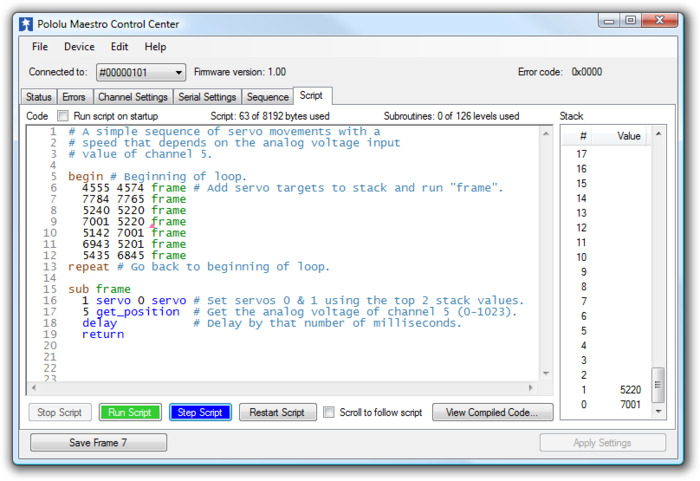 |
The Script tab in the Maestro Control Center. |
|---|
The Script tab is where you enter a script to be loaded into the Maestro. For details on the Maestro scripting language, see Section 6. Once you have entered a script and clicked the “Apply Settings” button to load the script on to the device, there are a number of options available for testing and debugging your script on the Script tab.
Running and stepping through a script
To start a script running, click the green button labeled “Run Script”. Your script will be processed by the Maestro, one instruction at a time, until a QUIT instruction is reached or an error occurs. In many cases it will be useful to use a loop of some kind to cause a script to run forever. While the script is running, the red “Stop Script” button will be available, and the small pink triangle will jump around your source code, showing you the instruction that is currently being executed. If the script places data on the stack, it will be visible on the right side of the tab, and nested subroutine calls are counted in a label at the top of the tab.
To examine the operation of a script in more detail, click the blue button labeled “Step Script”. This button causes the script to execute a single instruction, then stop and wait for another command. By stepping through the script a single instruction at a time, you can check that each part of your program does exactly what you expect it to do.
Setting the script to be run on startup
By default, the script only runs when you click the “Run Script” button. However, for many applications, you will want the script to run automatically, so that the Maestro can be used without a permanent USB connection. Check the “Run script on startup” option to cause the Maestro to automatically run the script whenever it is powered up. You will still be able to use the controls on the Script tab for debugging or to stop the running script.
Examining the compiled code
Click the “View Compiled Code” button to see the actual bytes that are created by each line of your script. This is available mostly as a tool for developers; if you are interested in the details of the bytecode used on the Maestro (for example, if you want to write your own compiler), please contact us. At the end of the compiled code is a listing of all of the subroutines, including their numbers in decimal and hex notation. These numbers can be used with serial commands to enter the subroutines under external control.
4.e. Errors
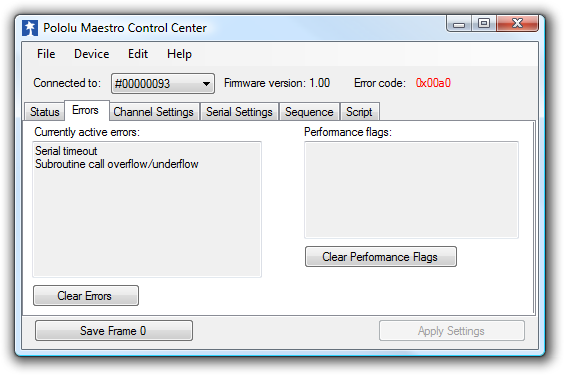 |
The Errors tab in the Maestro Control Center. |
|---|
The Errors tab indicates problems that the Maestro has detected while running, either communications errors or errors generated by bugs in a script.
Each error corresponds to a bit in the two-byte error register. The red LED will be on as long as any of the bits in the error register are set to 1 (it can also be turned on by the led_on script command). The value of the error register is displayed in the upper right corner of the main window.
When an error occurs, the corresponding bit in the error register is set to 1 and the Maestro sends all of its servos and digital outputs to their home positions, as specified in the Settings tab (Section 4.b). Any servos or outputs that are configured to be in the “Ignore” mode will not be changed. The error register is cleared by the “Get Errors” serial command.
The errors and their corresponding bit numbers are listed below:
- Serial signal error (bit 0)
A hardware-level error that occurs when a byte’s stop bit is not detected at the expected place. This can occur if you are communicating at a baud rate that differs from the Maestro’s baud rate. - Serial overrun error (bit 1)
A hardware-level error that occurs when the UART’s internal buffer fills up. This should not occur during normal operation. - Serial buffer full (bit 2)
A firmware-level error that occurs when the firmware’s buffer for bytes received on the RX line is full and a byte from RX has been lost as a result. This error should not occur during normal operation. - Serial CRC error (bit 3)
This error occurs when the Maestro is running in CRC-enabled mode and the cyclic redundancy check (CRC) byte at the end of the command packet does not match what the Maestro has computed as that packet’s CRC (Section 5.d). In such a case, the Maestro ignores the command packet and generates a CRC error. - Serial protocol error (bit 4)
This error occurs when the Maestro receives an incorrectly formatted or nonsensical command packet. For example, if the command byte does not match a known command or an unfinished command packet is interrupted by another command packet, this error occurs. - Serial timeout (bit 5)
When the serial timeout is enabled, this error occurs whenever the timeout period has elapsed without the Maestro receiving any valid serial commands. This timeout error can be used to make the servos return to their home positions in the event that serial communication between the Maestro and its controller is disrupted. - Script stack error (bit 6)
This error occurs when a bug in the user script has caused the stack to overflow or underflow. Any script command that modifies the stack has the potential to cause this error. The stack depth is 32 on the Micro Maestro and 126 on the Mini Maestros. - Script call stack error (bit 7)
This error occurs when a bug in the user script has caused the call stack to overflow or underflow. An overflow can occur if there are too many levels of nested subroutines, or a subroutine calls itself too many times. The call stack depth is 10 on the Micro Maestro and 126 on the Mini Maestros. An underflow can occur when there is a return without a corresponding subroutine call. An underflow will occur if you run a subroutine using the “Restart Script at Subroutine” serial command and the subroutine terminates with a return command rather than a quit command or an infinite loop. - Script program counter error (bit 8)
This error occurs when a bug in the user script has caused the program counter (the address of the next instruction to be executed) to go out of bounds. This can happen if your program is not terminated by a quit, return, or infinite loop.
Performance Flags
The errors tab also shows which performance flags have been set. This feature only applies to the Mini Maestro 12, 18, and 24. The performance flags indicate that the processor missed a deadline for performing a servo control task, and as a result the Maestro’s servo control got slowed down in some way. Performance flags should not occur during normal operation as long as your settings are within with the limitations described in Section 9.
4.f. Upgrading Firmware
Please do not attempt to upgrade your Maestro’s firmware unless you know what you are doing. Most customers do not need to upgrade their firmware.
The firmware is the program that runs on the Maestro. The Maestro has field-upgradeable firmware that can be easily updated with bug fixes or new features. There are four types of Maestros: the Micro Maestro 6-Channel USB Servo Controller (usc02a), the Mini Maestro 12-Channel USB Servo Controller (usc03a), the Mini Maestro 18-Channel USB Servo Controller (usc03b), and the Mini Maestro 24-Channel USB Servo Controller (usc03c). Each type of Maestro has its own firmware and you cannot load the firmware for one type onto another.
Firmware Versions
- Firmware Version 1.00: This is the original version of the firmware.
- Firmware Version 1.01 for the Micro Maestro 6-Channel USB Servo Controller: This firmware version was released on 2009-11-19 for the Micro Maestro only. It contains a bug-fix that makes “Ignore” mode servos behave correctly at startup.
- Firmware Version 1.02: This firmware version was released on 2013-06-20 for all four types of Maestros. This firmware version fixes a problem where in some cases the position of a servo with an acceleration limit would never settle to the target value. This update also fixes some minor problems with error handling. For the Mini Maestros, this update also fixes the yellow LED to blink the same way that it does on the Micro Maestro.
- Firmware Version 1.03: This firmware version was released on 2016-05-06 for all four types of Maestros. This firmware version fixes an issue that prevented the Maestros from working on macOS 10.11 or later.
- Firmware Version 1.04 for the Micro Maestro 6-Channel USB Servo Controller: This firmware version was released on 2019-06-10 for the Micro Maestro only. It fixes a bug where receiving a serial command could potentially interfere with the Maestro’s servo update routine, causing position updates for some servos to happen too soon or to be skipped entirely. Repeated serial commands at high baud rates could also trap the Maestro in the servo update routine, causing it to become unresponsive. This bug does not affect the Mini Maestros.
Upgrade Instructions
You can determine the version of your Maestro’s firmware by running the Maestro Control Center, connecting to a Maestro, and looking at the firmware version number which is displayed in the upper left corner next to the “Connected to” drop-down box. If you do not already have the latest version (1.03 for Mini Maestros, 1.04 for the Micro Maestro), you can upgrade by following the instructions below:
- Save the settings stored on your Maestro using the “Save settings file…” option in the File menu. All of your settings will be reset to default values during the firmware upgrade.
- Determine which type of Maestro you have either by counting the number of channels or by looking at the name that appears in your Device Manager. There are four types of Maestro: the Micro Maestro 6-Channel USB Servo Controller (usc02a), the Mini Maestro 12-Channel USB Servo Controller (usc03a), the Mini Maestro 18-Channel USB Servo Controller (usc03b), and the Mini Maestro 24-Channel USB Servo Controller (usc03c).
- Download the latest version of the firmware for your type of Maestro. It is important that you know which type of Maestro you have so that you can download the correct version. The latest firmware versions can be downloaded here:
- Firmware version 1.04 for the Micro Maestro 6-Channel USB Servo Controller (usc02a) (34k pgm)
- Firmware version 1.03 for the Mini Maestro 12-Channel USB Servo Controller (usc03a) (41k pgm)
- Firmware version 1.03 for the Mini Maestro 18-Channel USB Servo Controller (usc03b) (42k pgm)
- Firmware version 1.03 for the Mini Maestro 24-Channel USB Servo Controller (usc03c) (43k pgm)
- Connect your Maestro to a Windows or Linux computer using a USB cable.
- Run the Maestro Control Center and connect to the Maestro by selecting its serial number in the “Connected to:” drop-down box in the upper left corner.
- If you were not able to connect to the Maestro using the Maestro Control Center, double-check your USB connection, make sure all other devices are disconnected from the Maestro, and try plugging it into several different USB ports on your computer. If you are still unable to connect to it, see the instructions in Section 4.f.1 for doing a hard bootloader reset.
- Go to the Device menu and select “Upgrade firmware…”. You will see a message asking you if you are sure you want to proceed: click OK.
- If you are using Windows XP and see a Found New Hardware Wizard window appear, then you should follow steps 6–8 from Section 3.a to get the bootloader’s driver working.
- Once the Maestro is in bootloader mode and the bootloader’s drivers are properly installed, the green LED should be blinking in a double heart-beat pattern, and there should be an entry for the bootloader in the “Ports (COM & LPT)” list of your computer’s Device Manager.
- Go to the window entitled “Firmware Upgrade” that the Maestro Control Center has opened.
- Click the “Browse…” button and select the firmware file you downloaded. Make sure that the selected file is the right file for your type of Maestro (see steps 2 and 3).
- Select the COM port corresponding to the bootloader. If you do not know which COM port to select, go to the Device Manager and look in the “Ports (COM & LPT)” section.
- Click the “Program” button. You will see a message warning you that your device’s firmware is about to be erased and asking you if you are sure you want to proceed: click Yes.
- It will take a few seconds to erase the Maestro’s existing firmware and load the new firmware. Do not disconnect the Maestro during the upgrade.
- Once the upgrade is complete, the Firmware Upgrade window will close, the Maestro will disconnect from your computer, and it will reappear. If there is only one Maestro plugged in to your computer, the Maestro Control Center will connect to it. Check the firmware version number and make sure that it now indicates the latest version of the firmware.
If you have problems during or after the firmware upgrade, then it is possible that you loaded the wrong firmware onto your Maestro or some other problem corrupted the firmware. The solution is to retry the firmware upgrade procedure above. Even if your Maestro is not recognized at all by your computer and you see no sign of life from it, the instructions in step 6 and Section 4.f.1 can help you get the Maestro into bootloader mode. If you continue to have trouble after trying multiple times, please email us for assistance.
4.f.1. Hard Bootloader Reset
The instructions below describe how to force the Maestro into bootloader mode by performing a hard bootloader reset. Most customers do not need to use these instructions, but they can be used as a last resort in case something has gone wrong.
One reason to do a hard bootloader reset is if you accidentally loaded the wrong firmware onto your Maestro. The result of loading the wrong firmware is that your Maestro will have corrupted, unusable firmware. The Maestro will not be recognized by your computer and it will probably not blink any of its LEDs. In this case, the normal method for getting the Maestro into bootloader mode through the Maestro Control Center will not work, and you will have to resort to a hard bootloader reset. After that, the Maestro will be in bootloader mode and you can restore the Maestro’s correct firmware.
- To perform a hard bootloader reset, first make sure the Maestro is powered off. It is best if you can just disconnect everything from it.
- Using a screwdriver, a small piece of wire, or some other conductive tool, short the two exposed bootloader pads together. The pads are shown in the pictures below:
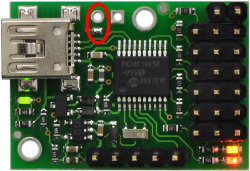 |
Bootloader pads for the Micro Maestro 6-Channel USB Servo Controller. |
|---|
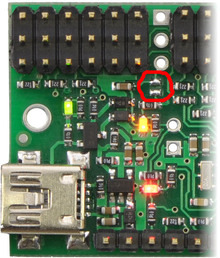 |
Bootloader pads for the Mini Maestro 12-, 18-, or 24-Channel USB Servo Controller. |
|---|
- While the pads are shorted together, connect the Maestro to USB. Usually the easiest way to do this is to have one end of the USB cable already plugged into the Maestro, and connect the other end to the computer after you have shorted the pads.
This might require a few tries. Once it works, you should see the green LED double-blinking, and the Maestro’s bootloader should be visible in your Device Manager (if you are using Windows). Then you can stop shorting together the pads and retry the firmware upgrade procedure in Section 4.f starting at step 7.
5. Serial Interface
5.a. Serial Settings
The Maestro has three different serial interfaces. First, it has the TX and RX lines, which allow the Maestro to send and receive non-inverted, TTL (0 – 5 V) serial bytes (Section 5.b). Secondly, the Maestro shows up as two virtual serial ports on a computer if it is connected via USB. One of these ports is called the Command Port and the other is called the TTL port.
- In Windows, you can determine the COM port numbers of these ports by looking in your computer’s Device Manager.
- In Linux, the Command Port will usually be
/dev/ttyACM0and the TTL Port will usually be/dev/ttyACM1. These numbers may be different on your computer depending on how many serial devices are active when you plug in the Maestro. - In Mac OS X 10.7 (Lion) and later, the Maestro’s two virtual serial ports will have a name of the form /dev/cu.usbmodem<number>, for example
/dev/cu.usbmodem00654321. The one with the lower number is the Command Port.
This section explains the serial interface configurations options available in the Serial Settings tab of the Maestro Control Center.
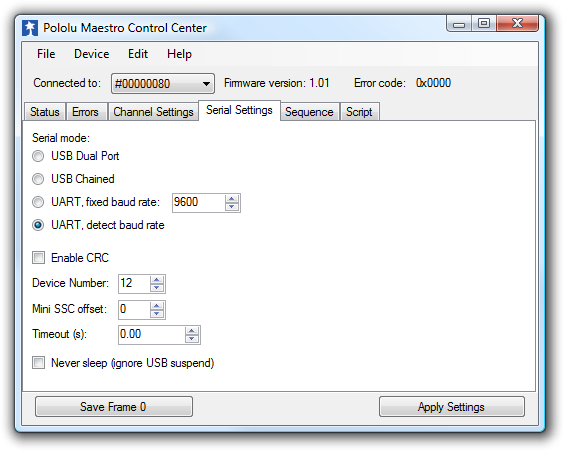 |
The Serial Settings tab in the Maestro Control Center. |
|---|
The Maestro can be configured to be in one of three basic serial modes:
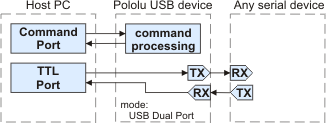 |
The USB Dual Port serial mode. |
|---|
USB Dual Port: In this mode, the Command Port can be used to send commands to the Maestro and receive responses from it. The baud rate you set in your terminal program when opening the Command Port is irrelevant. The TTL Port can be used to send bytes on the TX line and receive bytes on the RX line. The baud rate you set in your terminal program when opening the TTL Port determines the baud rate used to receive and send bytes on RX and TX. This allows your computer to control the Maestro and simultaneously use the RX and TX lines as a general purpose serial port that can communicate with other types of TTL serial devices.
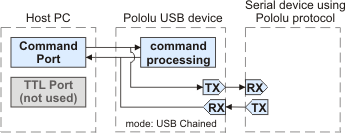 |
The USB Chained serial mode. |
|---|
USB Chained: In this mode, the Command Port is used to both transmit bytes on the TX line and send commands to the Maestro. The Maestro’s responses to those commands will be sent to the Command Port but not the TX line. Bytes received on the RX line will be sent to the Command Port but will not be interpreted as command bytes by the Maestro. The baud rate you set in your terminal program when opening the Command Port determines the baud rate used to receive and send bytes on RX and TX. The TTL Port is not used. This mode allows a single COM port on your computer to control multiple Maestros, or a Maestro and other devices that have a compatible protocol.
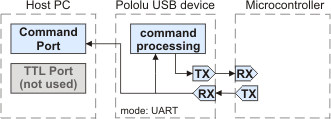 |
The UART serial mode. |
|---|
UART: In this mode, the TX and RX lines can be used to send commands to the Maestro and receive responses from it. Any byte received on RX will be sent to the Command Port, but bytes sent from the Command Port will be ignored. The TTL Port is not used. The baud rate on TX and RX can either be automatically detected by the Maestro when a 0xAA byte is received on RX, or it can be set to a fixed value specified in bits per second (bps). This mode allows you to control the Maestro (and send bytes to a serial program on the computer) using a microcontroller or other TTL serial device.
Other serial settings:
Enable CRC: If checked, the Maestro will require a cyclic redundancy check (CRC) byte at the end of every serial command except the Mini SSC command (see Section 5.d).
Device Number: This is the device number (0–127) that is used to address this device in Pololu Protocol commands. This setting is useful when using the Maestro with other devices in a daisy-chained configuration (see Section 5.g).
Mini SSC offset: This parameter determines which servo numbers the device will respond to in the Mini SSC protocol (see Section 5.e).
Timeout: This parameter specifies the duration before which a Serial timeout error will occur. This error can be used as a safety measure to ensure that your servos and digital outputs go back to their default states whenever the software sending commands to the Maestro stops working. The serial timeout error will occur whenever no valid serial commands (or qualifying native USB commands) are received within the specified timeout period. A timeout period of 0.00 disables the serial timeout error. The resolution of this parameter is 0.01 s and the maximum value available is 655.35 s. The native USB commands that qualify correspond to the following methods in the Usc class: setTarget, setSpeed, setAcceleration, setPwm, disablePWM, and clearErrors. Running the Maestro Control Center will not prevent the serial timeout error from occurring, but setting targets in the Status tab or playing a sequence will.
Never sleep (ignore USB suspend): By default, the Maestro’s processor will go to sleep and stop all of its operations whenever it detects that it is only powered by USB (no VIN supply) and that the USB has entered the Suspend State. However, this behavior can be disabled by checking the Never sleep checkbox.
5.b. TTL Serial
The Maestro’s serial receive line, RX, can receive bytes when connected to a logic-level (0 to 4.0–5 V, or “TTL”), non-inverted serial signal. The bytes sent to the Maestro on RX can be commands to the Maestro or an arbitrary stream of data that the Maestro passes on to a computer via the USB port, depending on which serial mode the Maestro is in (Section 5.a). The voltage on the RX pin should not go below 0 V and should not exceed 5 V.
The Maestro provides logic-level (0 to 5 V) serial output on its serial transmit line, TX. The bytes sent by the Maestro on TX can be responses to commands that request information or an arbitrary stream of data that the Maestro is receiving from a computer via the USB port and passing on, depending on which Serial Mode the Maestro is in. If you aren’t interested in receiving TTL serial bytes from the Maestro, you can leave the TX line disconnected.
The serial interface is asynchronous, meaning that the sender and receiver each independently time the serial bits. Asynchronous TTL serial is available as hardware modules called “UARTs” on many microcontrollers. Asynchronous serial output can also be “bit-banged” by a standard digital output line under software control.
The data format is 8 data bits, one stop bit, with no parity, which is often expressed as 8-N-1. The diagram below depicts a typical asynchronous, non-inverted TTL serial byte:
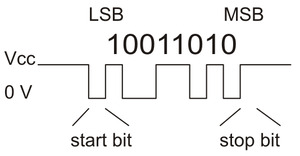 |
Diagram of a non-inverted TTL serial byte. |
|---|
A non-inverted TTL serial line has a default (non-active) state of high. A transmitted byte begins with a single low “start bit”, followed by the bits of the byte, least-significant bit (LSB) first. Logical ones are transmitted as high (VCC) and logical zeros are transmitted as low (0 V), which is why this format is referred to as “non-inverted” serial. The byte is terminated by a “stop bit”, which is the line going high for at least one bit time. Because each byte requires a start bit, 8 data bits, and a stop bit, each byte takes 10 bit times to transmit, so the fastest possible data rate in bytes per second is the baud rate divided by ten. At the Maestro’s maximum baud rate of 200,000 bits per second, the maximum realizable data rate, with a start bit coming immediately after the preceding byte’s stop bit, is 20,000 bytes per second.
Whenever connecting devices, remember to wire the grounds together, and ensure that each device is properly powered. Unpowered devices with a TTL serial port can turn on or partially on, drawing power from the serial line, which means that extra care must be taken when turning power off and on to reset the devices.
5.c. Command Protocols
You can control the Maestro by issuing serial commands.
If your Maestro’s serial mode is “UART, detect baud rate”, you must first send it the baud rate indication byte 0xAA on the RX line before sending any commands. The 0xAA baud rate indication byte can be the first byte of a Pololu protocol command.
The Maestro serial command protocol is similar to that of other Pololu products. Communication is achieved by sending command packets consisting of a single command byte followed by any data bytes that command requires. Command bytes always have their most significant bits set (128–255, or 0x80–0xFF in hex) while data bytes always have their most significant bits cleared (0–127, or 0x00–0x7F in hex). This means that each data byte can only transmit seven bits of information. The only exception to this is the Mini SSC command, where the data bytes can have any value from 0 to 254.
The Maestro responds to three sub-protocols:
Compact Protocol
This is the simpler and more compact of the two protocols; it is the protocol you should use if your Maestro is the only device connected to your serial line. The Maestro compact protocol command packet is simply:
command byte (with MSB set), any necessary data bytes
For example, if we want to set the target of servo 0 to 1500 µs, we could send the following byte sequence:
in hex: 0x84, 0x00, 0x70, 0x2E
in decimal: 132, 0, 112, 46
The byte 0x84 is the Set Target command, the first data byte 0x00 is the servo number, and the last two data bytes contain the target in units of quarter-microseconds.
Pololu Protocol
This protocol is compatible with the serial protocol used by our other serial motor and servo controllers. As such, you can daisy-chain a Maestro on a single serial line along with our other serial controllers (including additional Maestros) and, using this protocol, send commands specifically to the desired Maestro without confusing the other devices on the line.
To use the Pololu protocol, you transmit 0xAA (170 in decimal) as the first (command) byte, followed by a Device Number data byte. The default Device Number for the Maestro is 12, but this is a configuration parameter you can change. Any Maestro on the line whose device number matches the specified device number accepts the command that follows; all other Pololu devices ignore the command. The remaining bytes in the command packet are the same as the compact protocol command packet you would send, with one key difference: the compact protocol command byte is now a data byte for the command 0xAA and hence must have its most significant bit cleared. Therefore, the command packet is:
0xAA, device number byte, command byte with MSB cleared, any necessary data bytes
For example, if we want to set the target of servo 0 to 1500 µs for a Maestro with device number 12, we could send the following byte sequence:
in hex: 0xAA, 0x0C, 0x04, 0x00, 0x70, 0x2E
in decimal: 170, 12, 4, 0, 112, 46
Note that 0x04 is the command 0x84 with its most significant bit cleared.
Mini SSC Protocol
The Maestro also responds to the protocol used by the Mini SSC servo controller. This protocol allows you to control up to 254 different servos by chaining multiple servo controllers together. It only takes three serial bytes to set the target of one servo, so this protocol is good if you need to send many commands rapidly. The Mini SSC protocol is to transmit 0xFF (255 in decimal) as the first (command) byte, followed by a servo number byte, and then the 8-bit servo target byte. Therefore, the command packet is:
0xFF, servo number byte, servo target byte
For example, if we wanted to set the target of servo 0 to its (configurable) neutral position, we could send the following byte sequence:
in hex: 0xFF, 0x00, 0x7F
in decimal: 255, 0, 127
The Maestro can be configured to respond to any contiguous block of Mini SSC servo numbers from 0 to 254.
The Maestro identifies the Pololu, Compact, and Mini-SSC protocols on the fly; you do not need to use a configuration parameter to identify which protocol you are using, and you can freely mix commands in the three protocols.
5.d. Cyclic Redundancy Check (CRC) Error Detection
For certain applications, verifying the integrity of the data you are sending and receiving can be very important. Because of this, the Maestro has optional 7-bit cyclic redundancy checking, which is similar to a checksum but more robust as it can detect errors that would not affect a checksum, such as an extra zero byte or bytes out of order.
Cyclic redundancy checking can be enabled by checking the “Enable CRC” checkbox in the “Serial Settings” tab of the Maestro Control Center application. In CRC mode, the Maestro expects an extra byte to be added onto the end of every command packet (except Mini SSC command packets). The most-significant bit of this byte must be cleared, and the seven least-significant bits must be the 7-bit CRC for that packet. If this CRC byte is incorrect, the Maestro will set the Serial CRC error bit in the error register and ignore the command. The Maestro does not append a CRC byte to the data it transmits in response to serial commands.
A detailed account of how cyclic redundancy checking works is beyond the scope of this document, but you can find a wealth of information using Wikipedia. The CRC computation is basically a carryless long division of a CRC “polynomial”, 0x91, into your message (expressed as a continuous stream of bits), where all you care about is the remainder. The Maestro uses CRC-7, which means it uses an 8-bit polynomial and, as a result, produces a 7-bit remainder. This remainder is the lower 7 bits of the CRC byte you tack onto the end of your command packets.
The CRC implemented on the Maestro is the same as the one on the jrk and qik motor controller but differs from that on the TReX motor controller. Instead of being done MSB first, the computation is performed LSB first to match the order in which the bits are transmitted over the serial line. In standard binary notation, the number 0x91 is written as 10010001. However, the bits are transmitted in this order: 1, 0, 0, 0, 1, 0, 0, 1, so we will write it as 10001001 to carry out the computation below.
The CRC-7 algorithm is as follows:
- Express your 8-bit CRC-7 polynomial and message in binary, LSB first. The polynomial 0x91 is written as 10001001.
- Add 7 zeros to the end of your message.
- Write your CRC-7 polynomial underneath the message so that the LSB of your polynomial is directly below the LSB of your message.
- If the LSB of your CRC-7 is aligned under a 1, XOR the CRC-7 with the message to get a new message; if the LSB of your CRC-7 is aligned under a 0, do nothing.
- Shift your CRC-7 right one bit. If all 8 bits of your CRC-7 polynomial still line up underneath message bits, go back to step 4.
- What’s left of your message is now your CRC-7 result (transmit these seven bits as your CRC byte when talking to the Maestro with CRC enabled).
If you have never encountered CRCs before, this probably sounds a lot more complicated than it really is. The following example shows that the CRC-7 calculation is not that difficult. For the example, we will use a two-byte sequence: 0x83, 0x01.
Steps 1 & 2 (write as binary, least significant bit first,
add 7 zeros to the end of the message):
CRC-7 Polynomial = [1 0 0 0 1 0 0 1]
message = [1 1 0 0 0 0 0 1] [1 0 0 0 0 0 0 0] 0 0 0 0 0 0 0
Steps 3, 4, & 5:
_______________________________________________
1 0 0 0 1 0 0 1 ) 1 1 0 0 0 0 0 1 1 0 0 0 0 0 0 0 0 0 0 0 0 0 0
XOR 1 0 0 0 1 0 0 1 | | | | | | | | | | | | | | |
--------------- | | | | | | | | | | | | | | |
1 0 0 1 0 0 0 1 | | | | | | | | | | | | | |
shift ----> 1 0 0 0 1 0 0 1 | | | | | | | | | | | | | |
_______________ | | | | | | | | | | | | | |
1 1 0 0 0 0 0 0 | | | | | | | | | | |
1 0 0 0 1 0 0 1 | | | | | | | | | | |
_______________ | | | | | | | | | | |
1 0 0 1 0 0 1 0 | | | | | | | | | |
1 0 0 0 1 0 0 1 | | | | | | | | | |
_______________ | | | | | | | | | |
1 1 0 1 1 0 0 0 | | | | | | |
1 0 0 0 1 0 0 1 | | | | | | |
_______________ | | | | | | |
1 0 1 0 0 0 1 0 | | | | | |
1 0 0 0 1 0 0 1 | | | | | |
_______________ | | | | | |
1 0 1 0 1 1 0 0 | | | |
1 0 0 0 1 0 0 1 | | | |
_______________ | | | |
1 0 0 1 0 1 0 0 | |
1 0 0 0 1 0 0 1 | |
_______________ | |
1 1 1 0 1 0 0 = 0x17
So the full command packet we would send with CRC enabled is: 0x83, 0x01, 0x17.
5.e. Serial Servo Commands
The Maestro has several serial commands for setting the target of a channel, getting its current position, and setting its speed and acceleration limits.
Set Target (Pololu/Compact protocol)
Compact protocol: 0x84, channel number, target low bits, target high bits
Pololu protocol: 0xAA, device number, 0x04, channel number, target low bits, target high bits
The lower 7 bits of the third data byte represent bits 0–6 of the target (the lower 7 bits), while the lower 7 bits of the fourth data byte represent bits 7–13 of the target. The target is a non-negative integer.
If the channel is configured as a servo, then the target represents the pulse width to transmit in units of quarter-microseconds. A target value of 0 tells the Maestro to stop sending pulses to the servo.
If the channel is configured as a digital output, values less than 6000 tell the Maestro to drive the line low, while values of 6000 or greater tell the Maestro to drive the line high.
For example, if channel 2 is configured as a servo and you want to set its target to 1500 µs (1500×4 = 6000 = 01011101110000 in binary), you could send the following byte sequence:
in binary: 10000100, 00000010, 01110000, 00101110
in hex: 0x84, 0x02, 0x70, 0x2E
in decimal: 132, 2, 112, 46
Here is some example C code that will generate the correct serial bytes, given an integer “channel” that holds the channel number, an integer “target” that holds the desired target (in units of quarter microseconds if this is a servo channel) and an array called serialBytes:
serialBytes[0] = 0x84; // Command byte: Set Target. serialBytes[1] = channel; // First data byte holds channel number. serialBytes[2] = target & 0x7F; // Second byte holds the lower 7 bits of target. serialBytes[3] = (target >> 7) & 0x7F; // Third data byte holds the bits 7-13 of target.
Many servo control applications do not need quarter-microsecond target resolution. If you want a shorter and lower-resolution set of commands for setting the target you can use the Mini-SSC command below.
Set Target (Mini SSC protocol)
Mini-SSC protocol: 0xFF, channel address, 8-bit target
This command sets the target of a channel to a value specified by an 8-bit target value from 0 to 254. The 8-bit target value is converted to a full-resolution target value according to the range and neutral settings stored on the Maestro for that channel. Specifically, an 8-bit target of 127 corresponds to the neutral setting for that channel, while 0 or 254 correspond to the neutral setting minus or plus the range setting. These settings can be useful for calibrating motion without changing the program sending serial commands.
The channel address is a value in the range 0–254. By default, the channel address is equal to the channel number, so it should be from 0 to 23. To allow multiple Maestros to be controlled on the same serial line, set the Mini SSC Offset parameter to different values for each Maestro. The Mini SSC Offset is added to the channel number to compute the correct channel address to use with this command. For example, a Micro Maestro 6-channel servo controller with a Mini SSC Offset of 12 will obey Mini-SSC commands whose address is within 12–17.
Set Multiple Targets (Mini Maestro 12, 18, and 24 only)
Compact protocol: 0x9F, number of targets, first channel number, first target low bits, first target high bits, second target low bits, second target high bits, …
Pololu protocol: 0xAA, device number, 0x1F, number of targets, first channel number, first target low bits, first target high bits, second target low bits, second target high bits, …
This command simultaneously sets the targets for a contiguous block of channels. The first byte specifies how many channels are in the contiguous block; this is the number of target values you will need to send. The second byte specifies the lowest channel number in the block. The subsequent bytes contain the target values for each of the channels, in order by channel number, in the same format as the Set Target command above. For example, to set channel 3 to 0 (off) and channel 4 to 6000 (neutral), you would send the following bytes:
0x9F, 0x02, 0x03, 0x00, 0x00, 0x70, 0x2E
The Set Multiple Targets command allows high-speed updates to your Maestro, which is especially useful when controlling a large number of servos in a chained configuration. For example, using the Pololu protocol at 115.2 kbps, sending the Set Multiple Targets command lets you set the targets of 24 servos in 4.6 ms, while sending 24 individual Set Target commands would take 12.5 ms.
Set Speed
Compact protocol: 0x87, channel number, speed low bits, speed high bits
Pololu protocol: 0xAA, device number, 0x07, channel number, speed low bits, speed high bits
This command limits the speed at which a servo channel’s output value changes. The speed limit is given in units of (0.25 μs)/(10 ms), except in special cases (see Section 4.b). For example, the command 0x87, 0x05, 0x0C, 0x01 sets the speed of servo channel 5 to a value of 140, which corresponds to a speed of 3.5 μs/ms. What this means is that if you send a Set Target command to adjust the target from, say, 1000 μs to 1350 μs, it will take 100 ms to make that adjustment. A speed of 0 makes the speed unlimited. Setting the target of a channel that has a speed of 0 and an acceleration 0 will immediately affect the channel’s position. Note that the actual speed at which your servo moves is also limited by the design of the servo itself, the supply voltage, and mechanical loads; this parameter will not help your servo go faster than what it is physically capable of.
At the minimum speed setting of 1, the servo output takes 40 seconds to move from 1 to 2 ms.
The speed setting has no effect on channels configured as inputs or digital outputs.
Set Acceleration
Compact protocol: 0x89, channel number, acceleration low bits, acceleration high bits
Pololu protocol: 0xAA, device number, 0x09, channel number, acceleration low bits, acceleration high bits
This command limits the acceleration of a servo channel’s output. The acceleration limit is a value from 0 to 255 in units of (0.25 μs)/(10 ms)/(80 ms), except in special cases (see Section 4.b). A value of 0 corresponds to no acceleration limit. An acceleration limit causes the speed of a servo to slowly ramp up until it reaches the maximum speed, then to ramp down again as position approaches target, resulting in a relatively smooth motion from one point to another. With acceleration and speed limits, only a few target settings are required to make natural-looking motions that would otherwise be quite complicated to produce.
At the minimum acceleration setting of 1, the servo output takes about 3 seconds to move smoothly from a target of 1 ms to a target of 2 ms.
The acceleration setting has no effect on channels configured as inputs or digital outputs.
Set PWM (Mini Maestro 12, 18, and 24 only)
Compact protocol: 0x8A, on time low bits, on time high bits, period low bits, period high bits
Pololu protocol: 0xAA, device number, 0x0A, on time low bits, on time high bits, period low bits, period high bits
This command sets the PWM output to the specified on time and period, in units of 1/48 μs. The on time and period are both encoded with 7 bits per byte in the same way as the target in command 0x84, above. For more information on PWM, see Section 4.a. The PWM output is not available on the Micro Maestro.
Get Position
Compact protocol: 0x90, channel number
Pololu protocol: 0xAA, device number, 0x10, channel number
Response: position low 8 bits, position high 8 bits
This command allows the device communicating with the Maestro to get the position value of a channel. The position is sent as a two-byte response immediately after the command is received.
If the specified channel is configured as a servo, this position value represents the current pulse width that the Maestro is transmitting on the channel, reflecting the effects of any previous commands, speed and acceleration limits, or scripts running on the Maestro.
If the channel is configured as a digital output, a position value less than 6000 means the Maestro is driving the line low, while a position value of 6000 or greater means the Maestro is driving the line high.
If the channel is configured as an input, the position represents the voltage measured on the channel. The inputs on channels 0–11 are analog: their values range from 0 to 1023, representing voltages from 0 to 5 V. The inputs on channels 12–23 are digital: their values are either exactly 0 or exactly 1023.
Note that the formatting of the position in this command differs from the target/speed/acceleration formatting in the other commands. Since there is no restriction on the high bit, the position is formatted as a standard little-endian two-byte unsigned integer. For example, a position of 2567 corresponds to a response 0x07, 0x0A.
Note that the position value returned by this command is equal to four times the number displayed in the Position box in the Status tab of the Maestro Control Center.
Get Moving State (Mini Maestro 12, 18, and 24 only)
Compact protocol: 0x93
Pololu protocol: 0xAA, device number, 0x13
Response: 0x00 if no servos are moving, 0x01 if servos are moving
This command is used to determine whether the servo outputs have reached their targets or are still changing and will return 1 as long as there is at least one servo that is limited by a speed or acceleration setting still moving. Using this command together with the Set Target command, you can initiate several servo movements and wait for all the movements to finish before moving on to the next step of your program.
The Get Moving State command only works on the Mini Maestros. The Micro Maestro 6-channel controller implements the command, but it has a bug that could make this command return 0 when it should return 1. (The bug does not affect the GET_MOVING_STATE command in the scripting language, and it does not affect the Mini Maestros.) Therefore, we do not recommend using this command on a Micro Maestro. Instead, as a workaround, you could load the following script onto the Micro Maestro:
sub wait_for_movement_to_end begin get_moving_state while repeat quit
This script loops until GET_MOVING_STATE returns 0. You can use the “Restart Script at Subroutine” serial command to start the script and the “Get Script Status” serial command to check whether it is still running. These commands are documented in Section 5.f. If you start the script and then wait for it to stop running, it will mean that the servos have stopped moving.
Get Errors
Compact protocol: 0xA1
Pololu protocol: 0xAA, device number, 0x21
Response: error bits 0-7, error bits 8-15
Use this command to examine the errors that the Maestro has detected. Section 4.e lists the specific errors that can be detected by the Maestro. The error register is sent as a two-byte response immediately after the command is received, then all the error bits are cleared. For most applications using serial control, it is a good idea to check errors continuously and take appropriate action if errors occur.
Go Home
Compact protocol: 0xA2
Pololu protocol: 0xAA, device number, 0x22
This command sends all servos and outputs to their home positions, just as if an error had occurred. For servos and outputs set to “Ignore”, the position will be unchanged.
Note: For servos marked “Off”, if you execute a Set Target command immediately after Go Home, it will appear that the servo is not obeying speed and acceleration limits. In fact, as soon as the servo is turned off, the Maestro has no way of knowing where it is, so it will immediately move to any new target. Subsequent target commands will function normally.
5.f. Serial Script Commands
The Maestro has several serial commands for controlling the execution of the user script.
Stop Script
Compact protocol: 0xA4
Pololu protocol: 0xAA, device number, 0x24
This command causes the script to stop, if it is currently running.
Restart Script at Subroutine
Compact protocol: 0xA7, subroutine number
Pololu protocol: 0xAA, device number, 0x27, subroutine number
This command starts the script running at a location specified by the subroutine number argument. The subroutines are numbered in the order they are defined in your script, starting with 0 for the first subroutine. The first subroutine is sent as 0x00 for this command, the second as 0x01, etc. To find the number for a particular subroutine, click the “View Compiled Code…” button and look at the list below. Subroutines used this way should not end with the RETURN command, since there is no place to return to — instead, they should contain infinite loops or end with a QUIT command.
Restart Script at Subroutine with Parameter
Compact protocol: 0xA8, subroutine number, parameter low bits, parameter high bits
Pololu protocol: 0xAA, device number, 0x28, subroutine number, parameter low bits, parameter high bits
This command is just like the Restart Script at Subroutine command, except it loads a parameter on to the stack before starting the subroutine. Since data bytes can only contain 7 bits of data, the parameter must be between 0 and 16383.
Get Script Status
Compact protocol: 0xAE
Pololu protocol: 0xAA, device number, 0x2E
Response: 0x00 if the script is running, 0x01 if the script is stopped
This command responds with a single byte, either 0 or 1, to indicate whether the script is running (0) or stopped (1). Using this command together with the commands above, you can activate a sequence stored on the Maestro and wait until the sequence is complete before moving on to the next step of your program.
5.g. Daisy Chaining
This section is a guide to integrating the Maestro in to a project that has multiple TTL serial devices that use a compatible protocol. This section contains no new information about the Maestro: all of the information in this section can be deduced from the definitions of the three serial modes (Section 5.a) and the serial protocols used by the Maestro (Section 5.c).
First of all, you will need to decide whether to use the Pololu protocol, the Mini SSC protocol, or a mix of both. You must make sure that no serial command you send will cause unintended operations on the devices it was not addressed to. If you want to daisy chain several Maestros together, you can use a mixture of both protocols. If you want to daisy chain the Maestro with other devices that use the Pololu protocol, you can use the Pololu protocol. If you want to daisy chain the Maestro with other devices that use the Mini SSC protocol, you can use the Mini SSC protocol.
Secondly, assign each device in the project a different device number or Mini SSC offset so that they can be individually addressed by your serial commands. For the Maestro, this can be done in the Serial Settings tab of the Maestro Control Center application.
The following diagram shows how to connect one master and many slave devices together into a chain. Each of the devices may be a Maestro or any other device, such as a jrk, qik or other microcontroller.
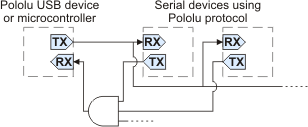 |
Daisy chaining serial devices using the Pololu protocol. An optional AND gate is used to join multiple TX lines. |
|---|
The Mini Maestro 12, 18, and 24 have a special input called TXIN that eliminates the need for an external AND gate (the AND gate is built in to the Maestro.) To make a chain of devices using the TXIN input, connect them like this:
 |
Daisy chaining serial devices that have a TXIN input. |
|---|
Using a PC and a Maestro together as the master device
The Maestro can enable a personal computer to be the master device. The Maestro must be connected to a PC with a USB cable and configured to be in either USB Dual Port or USB Chained serial mode. In USB Dual Port mode, the Command Port on the PC is used for sending commands directly to the Maestro, and the TTL Port on the PC is used to send commands to all of the slave devices. In the USB Chained mode, only the Command Port is used on the PC to communicate with the Maestro and all of the slave devices. Select the mode that is most convenient for your application or easiest to implement in your programming language.
Using a Maestro as a slave device
The Maestro can act as a slave device when configured to be in the UART serial mode. In this mode, commands are received on the RX line, and responses are sent on the TX line. A USB connection to a PC is not required, though an RX-only Comand Port is available on the PC for debugging or other purposes.
Connections
Connect the TX line of the master device to the RX lines of all of the slave devices. Commands sent by the master will then be received by all slaves.
Receiving serial responses from one of the slave devices on the PC can be achieved by connecting the TX line of that slave device to the RX line of the Maestro.
Receiving serial responses from multiple slave devices is more complicated. Each device should only transmit when requested, so if each device is addressed separately, multiple devices will not transmit simultaneously. However, the TX outputs are driven high when not sending data, so they cannot simply be wired together. Instead, you can use an AND gate, as shown in the diagram, to combine the signals. Note that in many cases receiving responses is not necessary, and the TX lines can be left unconnected.
Whenever connecting devices, remember to wire the grounds together, and ensure that each device is properly powered. Unpowered devices with a TTL serial port can turn on or partially on, drawing power from the serial line, which means that extra care must be taken when turning power off and on to reset the devices.
Sending commands
The Pololu Protocol or Mini SSC protocol should be used when multiple Pololu devices are receiving the same serial data. This allows the devices to be individually addressed, and it allows responses to be sent without collisions.
If the devices are configured to detect the baud rate, then when you issue your first Pololu Protocol command, the devices can automatically detect the baud from the initial 0xAA byte.
Some older Pololu devices use 0x80 as an initial command byte. If you want to chain these together with devices expecting 0xAA, you should first transmit the byte 0x80 so that these devices can automatically detect the baud rate, and only then should you send the byte 0xAA so that the Maestro can detect the baud rate. Once all devices have detected the baud rate, Pololu devices that expect a leading command byte of 0x80 will ignore command packets that start with 0xAA, and the Maestro will ignore command packets that start with 0x80.
5.h. Serial Example Code
5.h.1. Cross-platform C
The example C code below works on Windows, Linux, and Mac OS X 10.7 or later. It demonstrates how to set the target of a Maestro channel by sending a Set Target command to its Command Port, and how to read the position of a channel by sending the Get Position command. The Maestro’s serial mode needs to be set to “USB Dual Port” for this code to work. You will also need to modify the line that specifies the name of the COM port device.
This code will work in Windows if compiled with MinGW, but it does not work with the Microsoft C compiler. For Windows-specific example code that works with either compiler, see Section 5.h.2.
// Uses POSIX functions to send and receive data from a Maestro.
// NOTE: The Maestro's serial mode must be set to "USB Dual Port".
// NOTE: You must change the 'const char * device' line below.
#include <fcntl.h>
#include <stdio.h>
#include <unistd.h>
#ifdef _WIN32
#define O_NOCTTY 0
#else
#include <termios.h>
#endif
// Gets the position of a Maestro channel.
// See the "Serial Servo Commands" section of the user's guide.
int maestroGetPosition(int fd, unsigned char channel)
{
unsigned char command[] = {0x90, channel};
if(write(fd, command, sizeof(command)) == -1)
{
perror("error writing");
return -1;
}
unsigned char response[2];
if(read(fd,response,2) != 2)
{
perror("error reading");
return -1;
}
return response[0] + 256*response[1];
}
// Sets the target of a Maestro channel.
// See the "Serial Servo Commands" section of the user's guide.
// The units of 'target' are quarter-microseconds.
int maestroSetTarget(int fd, unsigned char channel, unsigned short target)
{
unsigned char command[] = {0x84, channel, target & 0x7F, target >> 7 & 0x7F};
if (write(fd, command, sizeof(command)) == -1)
{
perror("error writing");
return -1;
}
return 0;
}
int main()
{
// Open the Maestro's virtual COM port.
const char * device = "\\\\.\\COM6"; // Windows
//const char * device = "/dev/ttyACM0"; // Linux
//const char * device = "/dev/cu.usbmodem00034567"; // Mac OS X
int fd = open(device, O_RDWR | O_NOCTTY);
if (fd == -1)
{
perror(device);
return 1;
}
#ifdef _WIN32
_setmode(fd, _O_BINARY);
#else
struct termios options;
tcgetattr(fd, &options);
options.c_iflag &= ~(INLCR | IGNCR | ICRNL | IXON | IXOFF);
options.c_oflag &= ~(ONLCR | OCRNL);
options.c_lflag &= ~(ECHO | ECHONL | ICANON | ISIG | IEXTEN);
tcsetattr(fd, TCSANOW, &options);
#endif
int position = maestroGetPosition(fd, 0);
printf("Current position is %d.\n", position);
int target = (position < 6000) ? 7000 : 5000;
printf("Setting target to %d (%d us).\n", target, target/4);
maestroSetTarget(fd, 0, target);
close(fd);
return 0;
}
5.h.2. Windows C
For example C code that shows how to control the Maestro using its serial interface in Microsoft Windows, download MaestroSerialExampleCWindows.zip (4k zip). This zip archive contains a Microsoft Visual C++ 2010 Express project that shows how to send a Set Target command and also a Get Position command. It can also be compiled with MinGW. The Maestro’s serial mode needs to be set to “USB Dual Port” for this code to work. This example is like the previous example except it does the serial communication using Windows-specific functions like CreateFile and SetCommState. See the comments in the source code for more details.
5.h.3. PIC18F4550
The following example code for the PIC18F4550 was submitted to us by customer Ney Palma Castillo. It is intended to be compiled with the PIC MCU C Compiler. The code shows how to control a Maestro via serial commands using pins C6 and C7. It first commands the channel 0 servo to go to its minimum position and then, one second later, to go to its neutral position. Please see Section 5.e for information on connecting the PIC to the Maestro and set the Maestro’s serial mode to “UART, detect baud rate.”
#include<18f4550.H>
#fuses HSPLL, NOMCLR, PUT, BROWNOUT, BORV43, NOWDT, NOPROTECT, NOLVP
#fuses NODEBUG, USBDIV, PLL5, CPUDIV1, VREGEN, CCP2B3
#use delay(clock=48000000)
#define TTL_TX1 PIN_C6
#define TTL_RX1 PIN_C7
#use rs232(xmit=TTL_TX1, rcv=TTL_RX1, bits=8, parity=N)
void main() {
delay_ms(2000);
while(true) {
// Send a Set Target command using the Pololu protocol.
putc(0xAA); // Start Byte
putc(0x0C); // Device ID = 12
putc(0x04); // Command = Set Target
putc(0x00); // Channel = 0
putc(0x20); // Target position = 1000 us (typical minimum for servos)
putc(0x1F);
delay_ms(1000);
// Send another Set Target command using the Pololu protocol.
putc(0xAA);
putc(0x0C);
putc(0x04);
putc(0x00);
putc(0x70); // Target position = 1500 us (typical neutral for servos)
putc(0x2E);
delay_ms(1000);
}
}
5.h.4. Bash script
The following shell script sends Set Target commands to the Maestro’s virtual COM port. This script allows you to easily control a Maestro over USB from a computer running Linux or Mac OS X 10.7 (Lion) or later. To use it, you will need to first run the Maestro Control Center on a Linux or Windows computer and set the Maestro’s serial mode to “USB Dual Port”. Then, on the computer you want to control the Maestro from, you should copy the code below into a file named maestro-set-target.sh. You can run it using the example commands given below. You will need to change the DEVICE argument to be the name of the Maestro’s Command Port (see Section 5.a).
#!/bin/bash
# Sends a Set Target command to a Pololu Maestro servo controller
# via its virtual serial port.
# Usage: maestro-set-target.sh DEVICE CHANNEL TARGET
# Linux example: bash maestro-set-target.sh /dev/ttyACM0 0 6000
# Mac OS X example: bash maestro-set-target.sh /dev/cu.usbmodem00234567 0 6000
# Windows example: bash maestro-set-target.sh '\\.\COM6' 0 6000
# CHANNEL is the channel number
# TARGET is the target in units of quarter microseconds.
# The Maestro must be configured to be in USB Dual Port mode.
DEVICE=$1
CHANNEL=$2
TARGET=$3
byte() {
printf "\\x$(printf "%x" $1)"
}
stty raw -F $DEVICE
{
byte 0x84
byte $CHANNEL
byte $((TARGET & 0x7F))
byte $((TARGET >> 7 & 0x7F))
} > $DEVICE
This script can also be run on Windows, but since Windows does not have bash installed by default it is easier to use UscCmd.
5.h.5. Arduino library
We provide an Arduino library that makes it easier to control Maestro Servo Controllers with an Arduino. The library implements all of the serial commands available on the Maestro controllers and supports all three sub-protocols (Compact, Pololu, and MiniSSC). It also provides a number of example sketches, including ones that show how to:
- Control servos
- Smoothly control servo movement with acceleration and speed limits
- Control Maestro scripts
- Read inputs and receive feedback from the Maestro
- Control the PWM output available on Mini Maestros
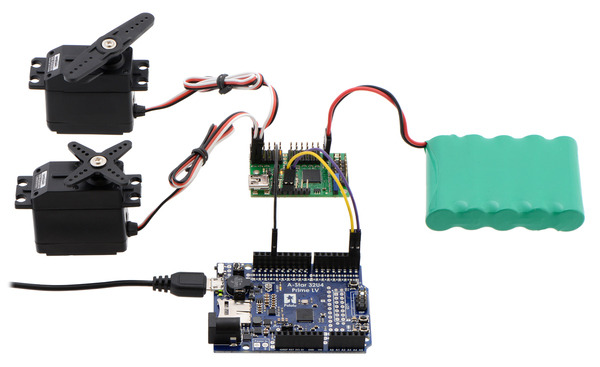 |
Example setup showing how to control a Maestro with an A-Star Prime or Arduino-compatible board. |
|---|
6. The Maestro Scripting Language
A script is a sequence of commands that is executed by the Maestro. Commands can set servo targets, speeds, and accelerations, retrieve input values, and perform mathematical computations. Basic control structures – looping and conditionals – are available for use in making complicated scripts. The Maestro script language is a simple stack-based language very similar to FORTH, and scripts compile to a compact bytecode in which commands and subroutine calls each take just a single byte. A basic editor/debugger is available in the Script tab of the Maestro Control Center application.
6.a. Maestro Script Language Basics
Commands and the stack
A program in the Maestro script language consists of a sequence of commands which act on a stack of values. Values in the stack are integers from -32768 to +32767. On the Micro Maestro 6-channel servo controller, there is room for up to 32 values on the stack, while on the Mini Maestro servo controllers there is room for up to 126 values on the stack. Commands always act on the topmost values of the stack and leave their results on the top of the stack. The simplest kind of commands are literals, numerical values that are placed directly onto the stack. For example, the program “-10 20 35 0” puts the values -10, 20, 35, and 0 sequentially onto the stack, so that it looks like this:
| value | |
|---|---|
| 3 | 0 |
| 2 | 35 |
| 1 | 20 |
| 0 | -10 |
A more complicated command is the PLUS command, which adds the top two numbers, leaving the result on the top of the stack. Suppose the numbers 1, 2, 4, and 7 are sequentially placed on the stack, and the PLUS command is run. The following table shows the result:
| before | after | |
|---|---|---|
| 3 | 7 | |
| 2 | 4 | 11 |
| 1 | 2 | 2 |
| 0 | 1 | 1 |
Note that the PLUS command always decreases the size of the stack by one. It is up to you to make sure that you have enough values on the stack to complete the commands you want to run!
Consider a more complicated example: suppose we want to compute the value of (1 – 3) × 4, using the MINUS and MULTIPLY commands. The way to write this computation as a script is “1 3 MINUS 4 TIMES”.
Comments, case, whitespace, and line breaks
All parts of the Maestro script language are case-insensitive, and you may use any kind of whitespace (spaces, tabs, and newlines) to separate commands. Comments are indicated by the pound sign “#” – everything from the # to the end of the line will be ignored by the compiler. For example, the computation above may be written as:
1 3 miNUS 4 # this is a comment! times
with absolutely no effect on the compiled program. We generally use lower-case for commands and two or four spaces of indentation to indicate control structures and subroutines, but feel free to arrange your code to suit your personal style.
Control structures
The Maestro script language has several control structures, which allow arbitrarily complicated programs to be written. Unlike subroutines, there is no limit to the level of nesting of control structures, since they are all ultimately based on GOTO commands (discussed below) and simple branching. By far the most useful control structure is the BEGIN…REPEAT infinite loop, an example of which is given below:
# move servo 1 back and forth with a period of 1 second begin 8000 1 servo 500 delay 4000 1 servo 500 delay repeat
This infinite loop will continue forever. If you want a loop that is bounded in some way, the WHILE keyword is likely to be useful. WHILE consumes the top number on the stack and jumps to the end of the loop if and only if it is a zero. For example, suppose we want to repeat this loop exactly 10 times:
10 # start with a 10 on the stack begin dup # copy the number on the stack - the copy will be consumed by WHILE while # jump to the end if the count reaches 0 8000 1 servo 500 delay 4000 1 servo 500 delay 1 minus # subtract 1 from the number of times remaining repeat
Note that BEGIN…WHILE…REPEAT loops are similar to the while loops of many other languages. But, just like everything else in the Maestro script language, the WHILE comes after its argument.
For conditional actions, an IF…ELSE…ENDIF structure is useful. Suppose we are building a system with a sensor on channel 3, and we want to set servo 5 to 6000 (1.5 ms) if the input value is less than 512 (about 2.5 V). Otherwise, we will set the servo to 7000 (1.75 ms). The following code accomplishes this relatively complicated task:
3 get_position # get the value of input 3 as a number from 0 to 1023 512 less_than # test whether it is less than 512 -> 1 if true, 0 if false if 6000 5 servo # this part is run when input3 < 512 else 7000 5 servo # this part is run when input3 >= 512 endif
As in most languages, the ELSE section is optional. Note again that this seems at first to be backwards relative to other languages, since the IF comes after the test.
The WHILE and IF structures are enough to create just about any kind of script. However, there are times when it is just not convenient to think about what you are trying to do in terms of a loop or a branch. If you just want to jump directly from one part of code to another, you may use a GOTO. It works like this:
goto mylabel # ...any code here is skipped... 4000 1 servo mylabel: # the program continues here 4000 2 servo
In this example, only servo 2 will get set to 4000, while servo 1 will be unchanged.
Subroutines
It can be useful to use the same sequence of commands many times throughout your program. Subroutines are used to make this easier and more space-efficient. For example, suppose you often need to set servo 1 and servo 2 back to their neutral positions of 6000 (1.5 ms) using the sequence “6000 1 servo 6000 2 servo”. You can encapsulate this in a subroutine as follows:
sub neutral 6000 1 servo 6000 2 servo return
Then, whenever you want send these two servos back to neutral, you can just use “neutral” as a command. More advanced subroutines take values off of the stack. For example, the subroutine
sub set_servos 2 servo 1 servo return
will set channel 2 to the value on the top of the stack and channel 1 to the next value. So, if you write “4000 6000 set_servos”, your script will set channel 1 to 4000 and channel 2 to 6000.
Subroutines can call other subroutines, up to a limit of 10 levels of recursion. For example, the subroutine “neutral” above can be implemented by calling set_servos:
sub neutral 6000 6000 set_servos return
6.b. Command Reference
The following is the entire list of commands and keywords in the Maestro script language. The “stack effect” column specifies how many numbers are consumed and added to the stack. For example, the PLUS command takes off two numbers and returns one; so it has a stack effect of -2,+1. Commands with special effects will be marked with a *.
Keywords
| keyword | stack effect | description |
|---|---|---|
| BEGIN | none | marks the beginning of a loop |
| ENDIF | none | ends a conditional block IF…ENDIF |
| ELSE | none | begins the alternative block in IF…ELSE…ENDIF |
| GOTO label | none | goes to the label label (define it with label:) |
| IF | -1 | enters the conditional block if the argument is true (non-zero) in IF…ENDIF or IF…ELSE…ENDIF |
| REPEAT | none | marks the end of a loop |
| SUB name | none | defines a subroutine name |
| WHILE | -1 | jumps to the end of a loop if the argument is false (zero) |
Control commands
| command | stack effect | description |
|---|---|---|
| QUIT | none | stops the script |
| RETURN | none | ends a subroutine |
Timing commands
| command | stack effect | description |
|---|---|---|
| DELAY | -1 | delays by the given number of milliseconds |
| GET_MS | +1 | gets the current millisecond timer (wraps around from 32767 to -32768) |
Stack commands
| command | stack effect | description |
|---|---|---|
| DEPTH | +1 | gets the number of numbers on the stack |
| DROP | -1 | removes the top number from the stack |
| DUP | +1 | duplicates the top number |
| OVER | +1 | duplicates the number directly below the top, copying it onto the top |
| PICK | -1,+1 | takes a number n between 0 and 63, then puts the nth number below the top onto the stack (0 PICK is equivalent to DUP) |
| SWAP | a,b → b,a | swaps the top two numbers |
| ROT | a,b,c → b,c,a | permutes the top three numbers so that the 3rd becomes the top and the others move down one position |
| ROLL | -1,* | takes a number n, then permutes the top n+1 numbers so that the n+1th becomes the top and all of the others move down one |
| PEEK | -1,+1 | (Mini Maestro 12, 18, and 24 only) takes a number n, then copies the nth value on the stack (measured from the bottom) to the top of the stack |
| POKE | -2,+1 | (Mini Maestro 12, 18, and 24 only) takes a number n, then removes the next value from the stack and puts it at the nth location on the stack (measured from the bottom) |
Mathematical commands (unary)
These commands take a single argument from the top of the stack, then return a single value as a result. Some of these have equivalents in C (and most other languages), listed in the “C equivalent” column below. We use “false” to mean 0 and “true” to mean any non-zero value. A command returning “true” always returns a 1.
| command | C equivalent | description |
|---|---|---|
| BITWISE_NOT | ~ | inverts all of the bits in its argument |
| LOGICAL_NOT | ! | replaces true by false, false by true |
| NEGATE | – | replaces x by -x |
| POSITIVE | none | true if and only if the argument is greater than zero |
| NEGATIVE | none | true if and only if the argument is less than zero |
| NONZERO | none | true (1) if and only if the argument is true (non-zero) |
Mathematical commands (binary)
These commands take two arguments from the top of the stack, then return a single value as a result. The order of the arguments, when important, is the standard one in mathematics; for example, to compute 1 – 2, you write “1 2 MINUS”. These commands all have equivalents in C (and most other languages), listed in the “C equivalent” column below.
| command | C equivalent | description |
|---|---|---|
| BITWISE_AND | & | applies the boolean AND function to corresponding bits of the arguments |
| BITWISE_OR | | | applies the boolean OR function to corresponding bits of the arguments |
| BITWISE_XOR | ^ | applies the boolean XOR function to corresponding bits of the arguments |
| DIVIDE | / | divides the arguments |
| EQUALS | == | true if and only if the arguments are equal |
| GREATER_THAN | > | true if and only if the first argument is greater than the second |
| LESS_THAN | < | true if and only if the first argument is less than the second |
| LOGICAL_AND | && | true if and only if both arguments are true |
| LOGICAL_OR | || | true if and only if at least one argument is true |
| MAX | none | selects the greater of the two arguments |
| MIN | none | selects the lesser of the two arguments |
| MINUS | – | subtracts the arguments |
| MOD | % | computes the remainder on division of the first argument by the second |
| NOT_EQUALS | != | true if and only if the arguments are not equal |
| PLUS | + | adds the arguments |
| SHIFT_LEFT | << | shifts the binary representation of the second argument to the left by a number of bits given in the second argument (without wrapping) |
| SHIFT_RIGHT | >> | shifts the binary representation of the first argument to the right by a number of bits given in the second argument (without wrapping) |
| TIMES | * | multiplies the arguments |
Servo, LED, and other output commands
| command | stack effect | description |
|---|---|---|
| SPEED | -2 | sets the speed of the channel specified by the top element to the value in the second element (see Section 4.b) |
| ACCELERATION | -2 | sets the acceleration of the channel specified by the top element to the value in the second element (see Section 4.b) |
| GET_POSITION | -1,+1 | gets the position of the channel specified by the top element |
| GET_MOVING_STATE | +1 | true if any servos that are limited by speed or acceleration settings are still moving |
| SERVO | -2 | sets the target of the channel specified by the top element to the value in the second element, in units of 0.25 μs |
| SERVO_8BIT | -2 | sets the target of the channel specified by the top element to the value in the second element, which should be a value from 0 to 254 (see the Mini SSC command in Section 5.e) |
| LED_ON | none | turns the red LED on |
| LED_OFF | none | turns the red LED off (assuming no errors bits are set) |
| PWM | -2 | (Mini Maestro 12, 18, and 24 only) enables the PWM output channel, with the period specified by the top element and the on time specified by the second element, both in units of 1/48 μs (see Section 4.a for more information about PWM) |
| SERIAL_SEND_BYTE | -1 | (Mini Maestro 12, 18, and 24 only) removes the top number from the stack, interprets it as a single byte, and sends that byte to the TTL serial output (TX) |
6.c. Example Scripts
Getting started: blinking an LED
The following script will cause the red LED on the Maestro to blink once per second:
# Blinks the red LED once per second. begin led_on 100 delay led_off 900 delay repeat
It is a good idea to try stepping through this script before doing anything further with scripts on the Maestro. In particular, pay attention to how the command “100” puts the number 100 on the stack, and the DELAY command consumes that number. In the Maestro scripting language, arguments to commands always need to be placed on the stack before the commands that use them, which makes the language seem backwards compared to other languages. It also means that you can arrange your code in a variety of different ways. For example, this program is equivalent to the one above:
# Blinks the red LED once per second. begin 900 100 led_on delay led_off delay repeat
The numbers are placed on the stack at the beginning of the loop, then consumed later on in execution. Pay attention to the order of the numbers used here: the 900 goes on the stack first, and it is used last.
A simple servo sequence
The following script shows how to direct servo 0 to five different positions in a loop.
# Move servo 0 to five different positions, in a loop. begin 4000 0 servo # set servo 0 to 1.00 ms 500 delay 5000 0 servo # 1.25 ms 500 delay 6000 0 servo # 1.50 ms 500 delay 7000 0 servo # 1.75 ms 500 delay 8000 0 servo # 2.00 ms 500 delay repeat
The serial mode must not be set to detect baud rate for this script to work. In detect baud rate mode, the Maestro does not enable any of the servo outputs until the start byte has been received.
Note that the servo positions are specified in units of 0.25 μs, so a value of 4000 corresponds to 1 ms. The text after the # is a comment; it does not get programmed on to the device, but it can be useful for making notes about how the program works. Good comments are essential for complicated programs. It is important to remember the DELAY commands; without these, the script will not wait at all between servo commands, running the loop hundreds of times per second.
Compressing the sequence
The program above takes 58 bytes of program space: 11 bytes for each servo position and 3 for the loop. At this rate, we could store up to 92 servo positions in the 1024-byte memory of the Micro Maestro, or 744 servo positions in the 8192-byte memory of the Mini Maestros. To get the most out of the limited memory, there are a variety of ways to compress the program. Most important is to make use of subroutines. For example, since we repeat the instructions “0 servo 500 delay” several times, we can move them into a subroutine to save space. At the same time, this simplifies the code and makes it easier to make future modifications, such as changing the speed of the entire sequence.
# Move servo 0 to five different positions, in a loop. begin 4000 frame 5000 frame 6000 frame 7000 frame 8000 frame repeat sub frame 0 servo 500 delay return
Using the subroutine brings the script down to 31 bytes: 4 per position and 11 bytes of overhead for the loop and to define FRAME. We can go further: inspecting the compiled code shows that putting each number on the stack requires 3 bytes: one byte as a command, and two for the two-byte number. Numbers from 0 to 255 can be loaded onto the stack with just two bytes. Suppose in our application we do not need the full 0.25 μs resolution of the device, since all of our settings are multiples of 100. Then we can use smaller numbers to save another byte:
# Move servo 0 to five different positions, in a loop. begin 40 frame 50 frame 60 frame 70 frame 80 frame repeat # loads a frame specified in 25 us units sub frame 100 times 0 servo 500 delay return
This program is 29 bytes long, with 3 bytes used per position and 14 bytes of overhead. Note that we could get the same efficiency if we used the SERVO_8BIT command, which takes a one-byte argument from 0 to 254. We can go even smaller by putting all of the numbers together:
# Move servo 0 to five different positions, in a loop. begin 80 70 60 50 40 frame frame frame frame frame repeat # loads a frame specified in 25 us units sub frame 100 times 0 servo 500 delay return
If you step through this version program, you will also notice that all five numbers are placed on the stack in a single step: this is because the compiler can use a single command to put multiple numbers on the stack. Using a single command for multiple numbers saves space: we are now down to just 26 bytes. Only 12 bytes are used for the 5 frames, for an average of 2.4 bytes per frame. This is probably compact enough – by duplicating this structure we could fit 420 different positions into the 1024-byte program memory of the Micro Maestro. However, the code can get even smaller. Consider this script, which uses 31 frames to make a smooth back-and-forth motion:
# Moves servo in a sine wave between 1 and 2 ms.
begin
60 64 68 71 74 77 79 80 80 79 78 76 73 70 66 62
58 54 50 47 44 42 41 40 40 41 43 46 49 52 56
all_frames
repeat
sub all_frames
begin
depth
while
100 times
0 servo
100 delay
repeat
return
In this version of the code, we have rewritten the FRAME subroutine, using the DEPTH command to automatically load frames from the stack until there are none left. This program uses 34 bytes to store 31 frames, for an average of just 1.1 bytes per frame. We could store a sequence containing 900 different positions in the memory of the Micro Maestro using this kind of script.
Making smooth sequences with GET_MOVING_STATE
Speed and acceleration settings can be used to make smooth motion sequences with the Maestro. However, a common problem is that you do not know how much you need to delay between frames to allow the servo to reach its final position. Here is an example of how to use the built-in function GET_MOVING_STATE to make a smooth sequence, instead of DELAY:
# This example uses speed and acceleration to make a smooth
# motion back and forth between 1 and 2 ms.
3 0 acceleration
30 0 speed
begin
4000 0 servo # set servo 0 to 1.00 ms
moving_wait
8000 0 servo # 2.00 ms
moving_wait
repeat
sub moving_wait
begin
get_moving_state
while
# wait until it is no longer moving
repeat
return
GET_MOVING_STATE returns a 1 as long as there is at least one servo that is limited by a speed or acceleration setting still moving, so you can use it whenever you want to wait for all motion to stop before proceeding to the next step of a script.
Using an analog input to control servos
An important feature of the Maestro is that it can be used to read inputs from sensors, switches, or other devices. As a simple example, suppose we want to use a potentiometer to control the position of a servo. For this example, connect the potentiometer to form a voltage divider between 5V and 0, with the center tap connected to channel 1. Configure channel 1 to be an input, and examine the signal on the Status tab of the Maestro Control Center. You should see the position indicator vary from 0 to 255 μs as you turn the potentiometer from one side to the other. In your script, this range corresponds to numbers from 0 to 1023. We can scale this number up to approximately the full range of a servo, then set the servo position to this number, all in a loop:
# Sets servo 0 to a position based on an analog input. begin 1 get_position # get the value of the pot, 0-1023 4 times 4000 plus # scale it to 4000-8092, approximately 1-2 ms 0 servo # set servo 0 based to the value repeat
Alternatively, you might want the servo to go to discrete positions depending on the input value:
# Set the servo to 4000, 6000, or 8000 depending on an analog input.
begin
1 get_position # get the value of the pot, 0-1023
dup 300 less_than
if
4000 # go to 4000 for values 0-299
else
dup 600 less_than
if
6000 # go to 6000 for values 300-599
else
8000 # go to 8000 for values 600-1023
endif
endif
0 servo
drop # remove the original copy of the pot value
repeat
The example above works, but when the potentiometer is close to 300 or 600, noise on the analog-to-digital conversion can cause the servo to jump randomly back and forth. A better way to do it is with hysteresis:
# Set the servo to 4000, 6000, or 8000 depending on an analog input, with hysteresis.
begin
4000 0 300 servo_range
6000 300 600 servo_range
8000 600 1023 servo_range
repeat
# usage: <pos> <low> <high> servo_range
# If the pot is in the range specified by low and high,
# keeps servo 0 at pos until the pot moves out of this
# range, with hysteresis.
sub servo_range
pot 2 pick less_than logical_not # >= low
pot 2 pick greater_than logical_not # <= high
logical_and
if
begin
pot 2 pick 10 minus less_than logical_not # >= low - 10
pot 2 pick 10 plus greater_than logical_not # <= high + 10
logical_and
while
2 pick 0 servo
repeat
endif
drop drop drop
return
sub pot
1 get_position
return
This example uses one range for deciding where to go when making a transition, then it waits for the servo to leave a slightly larger range before making another transition. As long as the difference (10 in this example) is larger than the amount of noise, this will prevent the random jumping.
Note that this example will only work if you connect your potentiometer to one of the analog input capable channels (channels 0–11). The inputs on the other channels are digital.
Using a button or switch to control servos
It is possible to connect a button or switch to a Maestro and detect the state of the button in your script. The script below moves a servo through a predefined sequence of movements, advancing to the next step each time the button is pushed. It uses channel 0 for the button and channel 1 for the servo.
The button channel must be configured as an input and wired correctly. See Section 7.b for instructions on how to wire a button to your Maestro using a pull-up resistor, so that the input is normally high, and when the button is pressed it goes low.
goto main_loop # Run the main loop when the script starts (see below).
# This subroutine returns 1 if the button is pressed, 0 otherwise.
# To convert the input value (0-1023) to a digital value (0 or 1) representing
# the state of the button, we make a comparison to an arbitrary threshold (500).
# This subroutine puts a logical value of 1 or a 0 on the stack, depending
# on whether the button is pressed or not.
sub button
0 get_position 500 less_than
return
# This subroutine uses the BUTTON subroutine above to wait for a button press,
# including a small delay to eliminate noise or bounces on the input.
sub wait_for_button_press
wait_for_button_open_10ms
wait_for_button_closed_10ms
return
# Wait for the button to be NOT pressed for at least 10 ms.
sub wait_for_button_open_10ms
get_ms # put the current time on the stack
begin
# reset the time on the stack if it is pressed
button
if
drop get_ms
else
get_ms over minus 10 greater_than
if drop return endif
endif
repeat
# Wait for the button to be pressed for at least 10 ms.
sub wait_for_button_closed_10ms
get_ms
begin
# reset the time on the stack if it is not pressed
button
if
get_ms over minus 10 greater_than
if drop return endif
else
drop get_ms
endif
repeat
# An example of how to use wait_for_button_press is shown below:
# Uses WAIT_FOR_BUTTON_PRESS to allow a user to step through
# a sequence of positions on servo 1.
main_loop:
begin
4000 frame
5000 frame
6000 frame
7000 frame
8000 frame
repeat
sub frame
wait_for_button_press
1 servo
return
Just like the sequencing examples above, the script steps through a sequence of frames, but instead of a timed delay between frames, this example waits for a button press. The WAIT_FOR_BUTTON_PRESS subroutine can be used in a variety of different scripts, whenever you want to wait for a button press. You could also expand this example to allow multiple buttons, continuous motion, or a variety of other types of button control.
Using multiple buttons or switches to control servos
This script demonstrates how to connect your Maestro to multiple buttons. When a button is pressed, it runs the corresponding sequence.
# When the script is not doing anything else, # this loop will listen for button presses. When a button # is pressed it runs the corresponding sequence. begin button_a if sequence_a endif button_b if sequence_b endif button_c if sequence_c endif repeat # These subroutines each return 1 if the corresponding # button is pressed, and return 0 otherwise. # Currently button_a is assigned to channel 0, # button_b is assigned to channel 1, and # button_c is assigned to channel 2. # These channels must be configured as Inputs in the # Channel Settings tab. sub button_a 0 get_position 500 less_than return sub button_b 1 get_position 500 less_than return sub button_c 2 get_position 500 less_than return # These subroutines each perform an arbitrary sequence # of servo movements. You should change these to fit # your application. sub sequence_a 4000 3 servo 1000 delay 6000 3 servo 500 delay return sub sequence_b 8000 4 servo 900 delay 7000 4 servo 900 delay 6000 4 servo 900 delay return sub sequence_c 10 4 speed 7000 4 servo 3000 delay 6000 4 servo 3000 delay return
Please note that this script does not do multi-tasking. If a sequence is running, the script will not detect other button presses until the sequence is done. It is possible to make the buttons operate independently, but the script would need to be much more complicated. Depending on how skilled you are at writing scripts, you might prefer to use multiple Maestros instead.
Long delays
The longest delay possible with the DELAY command is approximately 32 seconds. In some cases, you will want to make delays much longer than that. Here is an example that shows how delays of many seconds or minutes can be accomplished:
# Moves servo 0 back and forth, with a delay of 10 minutes between motions.
begin
4000 0 servo
10 delay_minutes
8000 0 servo
10 delay_minutes
repeat
# delay by a specified number of seconds, up to 65535 s
sub delay_seconds
begin dup while # check if the count has reached zero
1 minus 1000 delay # subtract one and delay 1s
repeat
drop return # remove the 0 from the stack and return
# delay by a specified number of minutes, up to 65535 min
sub delay_minutes
begin dup while
1 minus 60 delay_seconds # subtract one and delay 1min
repeat
drop return # remove the 0 from the stack and return
It is easy to write subroutines for delays of hours, days, weeks, or whatever you want. Keep in mind, however, that the timer on the Micro Maestro is not as accurate as a stopwatch – these delays could easily be off by 1%.
Digital output
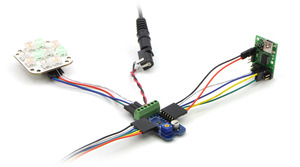 |
Connecting the Micro Maestro to a chain of ShiftBars. A single 12V supply powers all of the devices. |
|---|
The digital output feature of the Maestro is capable of controlling anything from simple circuits to intelligent devices such as the ShiftBrite LED Modules and ShiftBar LED Controllers, which use a simple synchronous serial protocol. In this example, the clock, latch, and data pins of a ShiftBrite or ShiftBar are connected to servo channels 0, 1, and 2, respectively, and these channels are all configured as outputs. The subroutine RGB defined here takes 10-bit red, green, and blue values from the stack, then sends a 32-byte color packet and toggles the latch pin to update the ShiftBrite with the new color value. The subroutine could be modified to control a larger chain of ShiftBrites if desired.
begin
1023 0 0 rgb 500 delay # red
0 1023 0 rgb 500 delay # green
0 0 1023 rgb 500 delay # blue
repeat
# Subroutine for setting the RGB value of a ShiftBrite/ShiftBar.
# example usage: 1023 511 255 rgb
sub rgb
0 send_bit # this bit does not matter
0 send_bit # the "address" bit - 0 means a color command
swap rot rot
send_10_bit_value
send_10_bit_value
send_10_bit_value
0 1 8000 1 servo servo # toggle the latch pin
return
# sends a numerical value as a sequence of 10 bits
sub send_10_bit_value
512
begin
dup
while
over over bitwise_and send_bit
1 shift_right
repeat
drop drop
return
# sends a single bit
sub send_bit
if 8000 else 0 endif
2 servo # set DATA to 0 or 1
0 0 8000 0 servo servo # toggle CLOCK
return
Note that we use 0 to set the output low and 8000 to set the output high. These are reasonable choices, but any value from 0 to 5999 could be used for low, and anything from 6000 to 32767 could be used for high, if desired.
Serial output (Mini Maestro 12, 18, and 24 only)
On the Mini Maestro 12, 18, and 24, a script can be used to send serial data out on the TTL-level serial port (TX). This means that the Maestro can control additional Maestros, allowing for large numbers of channels without a separate microcontroller. Here is a simple program that shows how a serial command can be used to control another Maestro. To use this code, configure both Maestros in UART mode at the same baud rate, and connect TX on the master to RX on the slave.
100 delay # initial delay to make sure that the other maestro has time to initialize begin 127 0 mini_ssc # set servo 0 to position 127, using the mini-SSC command 254 0 mini_ssc # set servo 0 to position 254 repeat sub mini_ssc 0xFF serial_send_byte serial_send_byte serial_send_byte return
6.d. Script Specifications
The user scripting language available on the Mini Maestros is more powerful than that available on the Micro Maestro. The differences are summarized in the table below.
| Micro Maestro | Mini Maestro 12, 18, and 24 | |
|---|---|---|
| Script size: | 1KB | 8 KB |
| Stack size: | 32 | 126 |
| Call stack size: | 10 | 126 |
| Number of subroutines: | 128 | unlimited |
| Extra commands: | PEEK, POKE, PWM, SERIAL_SEND_BYTE |
Script size: This is the number of bytes of persistent memory that can be used to store your code. A bigger script size allows you to store more servo motion frames and to write more complex programs.
Stack size: This is the maximum number of values that can be on the stack at the same time. A bigger stack allows you to have more variables, do bigger computations, and worry less about whether the stack will overflow.
Call stack size: This is the maximum subroutine nesting depth (the maximum number of subroutines that can be called without returning).
Number of subroutines: This is the number of different subroutines you are allowed to have.
The first 128 subroutines defined in your script are special: these subroutines can be started using a serial or native USB command, and each call from within your script requires only one byte of script space. The Micro Maestro only supports having up to 128 subroutines. The Mini Maestro 12, 18, and 24 support having an unlimited number of subroutines, but the subroutines defined after the first 128 can not be started from a serial or native USB command, and each call requires 3 bytes of script space.
7. Wiring Examples
This section contains example wiring configurations for the Maestro that demonstrate the different ways it can be connected to your project. Although many of the pictures only show the Micro Maestro, the information in this section applies to all Maestros (unless otherwise noted).
7.a. Powering the Maestro
There are several ways to power your Maestro’s processor and the servos it is controlling.
USB power
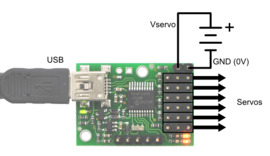 |
The Micro Maestro’s processor can be powered from USB while the servos are powered by a separate supply. |
|---|
If you connect a power supply to the servo power terminal and connect the Maestro to USB as shown in the picture to the right, then the Maestro’s processor will be powered from USB while the servos are powered from the power supply. The power supply must output a voltage within the servos’ respective operating ranges and must be capable of supplying all the current that the servos will draw.
In this configuration, if the computer (or other USB host) that the Maestro is connected to goes to sleep, then by default the Maestro will go to sleep and stop sending servo pulses. If you need to drive your servos while your computer is off, you can use the Never sleep (ignore USB suspend) option in the Serial Settings tab of the Maestro Control Center. Note that this will only work if the computer is supplying power to the USB port while it is asleep, and it will make your Maestro be non-USB-compliant.
Two power supplies
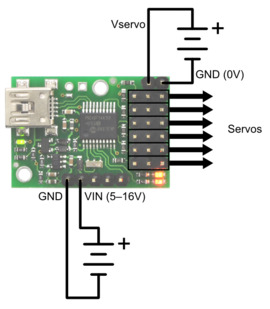 |
The Micro Maestro’s processor and servos can be powered separately. |
|---|
If you connect a power supply to the servo power terminal and connect another power supply to GND/VIN, then the Maestro’s processor will be powered from the VIN supply while the servos are powered from their own supply. The VIN supply must be within 5–16 V and be capable of supplying at least 30 mA to the Micro Maestro or 50 mA to the Mini Maestro. The servo power supply must output a voltage within the servos’ respective operating ranges and must be capable of supplying all the current that the servos will draw.
One power supply
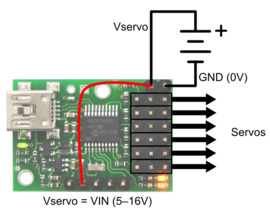 |
The Micro Maestro’s processor and servos can be powered from a single 5–16V supply if you connect the positive servo power rail to VIN. |
|---|
If you connect a single power supply to VIN and the servo power terminal, then the Maestro’s processor and the servos will be powered from that supply. The supply must be within 5–16 V and be within the servos’ respective operating ranges and must be capable of supplying all the current that the servos will draw.
On the Micro Maestro 6-channel servo controller, one way to do the wiring for this configuration is to add a wire between the servo power rail and the VIN line.
On the Mini Maestro 12-, 18-, and 24-channel servo controllers, the recommended way to do the wiring for this configuration is to connect your power supply to the dedicated servo power pins in the corner of the board and use the included blue shorting block to connect the pins labeled “VSRV=VIN”.
7.b. Attaching Servos and Peripherals
On the Maestro, any of the channels can be used as RC servo pulse output, as an analog/digital input, or as a digital output. This allows the Maestro to control servos, read button presses, read potentiometer positions, drive LEDs, and more. The channels can be controlled from the user script within the Maestro or externally over TTL-level serial or USB.
Servo
To connect a servo to the Maestro, you must first decide which channel you would like to use. If the channel is not already configured to be in servo mode (the default), then in the Maestro Control Center, under the Channel Settings tab, change that channel to Servo mode and click “Apply Settings”. Connect your servo cable to the channel, being careful not to plug it in backwards. Make sure to connect your servo correctly, or it might be destroyed. The signal (usually white, orange, or yellow) wire should be toward the inside of the board, and the ground wire (usually black or brown) should be closest to the edge of the board.
You will need to connect a DC power supply for your servos. See Section 7.a for powering information.
You can test your servo by setting the target of the servo channel in the Status tab of the Maestro Control Center. If you enable the servo channel by checking the “Enabled” checkbox, you should be able to make the servo move by dragging the slider bar left and right. Now you can control the servos in your script using the SERVO command, or over serial using the “Set Target” command. These commands take arguments in units of quarter-microseconds, so you should multiply the Target values you see in the Status tab by four to compute correct arguments to these commands. More advanced commands are also available for controlling your servos.
Button or switch
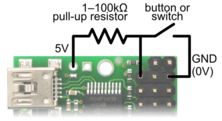 |
Diagram for connecting a button or switch to the Micro Maestro Servo Controller. |
|---|
To connect a button or switch to the Maestro, you must first decide which channel you would like to use. In the Maestro Control Center, under the Channel Settings tab, change that channel to Input mode and click “Apply Settings”. Next, wire a pull-up resistor (1–100 kilo-ohms) between the signal line of that channel and 5 V so that the input is high (5 V) when the switch is open. Wire the button or switch between the signal line and GND (0 V) so that when the button/switch is active the input will fall to 0 V. The picture to the right shows how to connect a button or switch to channel 0 on the Micro Maestro 6-channel servo controller.
Note: An external pull-up resistor is not needed if you use channel 18, 19, or 20 on the Mini Maestro 24-channel servo controller and enable its internal pull-up resistor in Channel Settings tab of the Maestro Control Center.
You can test your input by toggling the button/switch and verifying that the “Position” variable as shown in the Status tab of the Maestro Control Center reflects the state of your button/switch: it should be close to 255.75 when the button/switch is inactive and close to 0 when it is active. Now you can read the state of the button/switch in your script using the GET_POSITION command or over serial using the “Get Position” command. These commands will return values that are close to 1023 when the button/switch is inactive and close to 0 when it is active.
Potentiometer
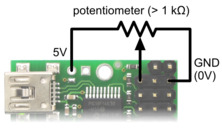 |
Diagram for connecting a potentiometer to the Micro Maestro servo controller. |
|---|
To connect a potentiometer to the Maestro, you must first decide which channel you would like to use. If you have the Mini Maestro 18- or 24-channel servo controller, be sure to pick one of the analog input capable channels (channels 0–11). In the Maestro Control Center, under the Channel Settings tab, change that channel to Input mode and click “Apply Settings”. Next, connect the potentiometer to the Maestro so that the two ends go to GND and 5 V, and the wiper connects to the signal line of the channel. The picture to the right shows how to connect a potentiometer to channel 0 on the Micro Maestro 6-channel servo controller. The potentiometer should have a resistance of at least 1 kilo-ohm so that it does not draw too much current from the 5V line.
You can test your input by rotating the potentiometer and verifying that the “Position” variable as shown in the Status tab of the Maestro Control Center reflects the position of the potentiometer: it should vary between approximately 255.75 and 0. Now you can read the position of the potentiometer in your script using the GET_POSITION command or over serial using the “Get Position” command. These commands will return values between approximately 1023 and 0.
LED
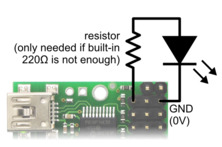 |
Diagram for connecting an LED to the Micro Maestro servo controller. |
|---|
To connect an LED to the Maestro, you should first decide which channel you would like to use. In the Maestro Control Center, under the Channel Settings tab, change that channel to Output mode and click “Apply Settings”. Next, connect the cathode of the LED to GND (any ground pad on the Maestro will suffice because they are all connected). Then connect the anode of the LED to the channel’s signal line (through a resistor is needed). The signal line has a 220 ohm resistor for protection, which means you can connect most LEDs directly to the signal line. However, you should read your LED’s datasheet to make sure, and add your own resistor if needed.
You can test your LED by setting the “target” of the LED channel in the Status tab of the Maestro Control Center. The LED should be on if you set the target to be greater than or equal to 1500 μs and off otherwise. You can control the LED in your script using the SERVO command or over serial using the “Set Target” command. These commands take arguments in units of quarter-microseconds, so the LED should be on if you send a number greater than or equal to 6000 and off otherwise.
7.c. Connecting to a Microcontroller
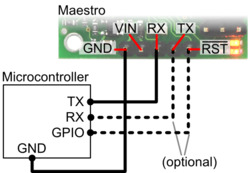 |
Diagram showing how to connect the Micro Maestro servo controller to a microcontroller. |
|---|
The Maestro can accept TTL serial commands from a microcontroller. To connect the microcontroller to the Maestro, you should first connect the ground line of the microcontroller to the ground line of the Maestro. Then connect the TX (serial transmit) line of the microcontroller to the RX line of the Maestro so that the microcontroller can send commands. If you need to receive serial responses from the Maestro, then you will need to connect the RX (serial receive) line of the microcontroller to the Maestro’s TX line. For more information on the different serial modes and commands, see Section 5.
If you want your microcontroller to have the ability to reset the Maestro, then connect the RST line of the Maestro to any general-purpose I/O line of the microcontroller. You should have the I/O line tri-stated or at 5 V when you want the Maestro to run and drive it low (0 V) temporarily to reset the Maestro.
If you want your microcontroller to have the ability to detect errors from the Maestro using a digital input instead of the serial command, or you want to receive direct feedback from the user script, then connect the ERR line of the Maestro to any general-purpose I/O line of the microcontroller. The ERR line is only available on the Mini Maestro 12-, 18-, and 24-channel servo controllers. See Section 1.b for more information about the ERR line.
8. Writing PC Software to Control the Maestro
There are two ways to write PC software to control the Maestro: the native USB interface and the virtual serial port. The native USB interface provides more features than the serial port, such as the ability to change configuration parameters and select the Maestro by its serial number. Also, the USB interface allows you to recover more easily from temporary disconnections. The virtual serial port interface is easier to use if you are not familiar with programming, and it can work with existing software programs that use serial ports, such as LabView.
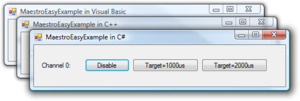 |
The Pololu USB SDK contains example code for the Maestro in C#, Visual C++, and Visual Basic .NET. |
|---|
Native USB Interface
The Pololu USB Software Development Kit supports Windows and Linux, and includes the source code for:
- MaestroEasyExample: a simple example application that uses native USB and has three buttons that control the Maestro. Versions of this example are available in C#, Visual Basic .NET, and Visual C++.
- MaestroAdvancedExample: an example graphical application that uses native USB to send commands and receive feedback from the Maestro and automatically recover from disconnection (written in C#).
- UscCmd: a command-line utility for configuring and controlling the Maestro (written in C#).
- C# .NET class libraries that enable native USB communication with the Maestro (written in C#).
You can modify the applications in the SDK to suit your needs or you can use the class libraries to integrate the Maestro in to your own applications.
Example code that uses the native USB interface from other languages can be found in Section 10.
Virtual Serial Ports
Almost any programming language is capable of accessing the COM ports created by the Maestro. We recommend the Microsoft .NET framework, which is free to use and contains a SerialPort class that makes it easy to read and write bytes from a serial port. You can download Visual Studio Express (for either C#, C++, or Visual Basic) and write programs that use the SerialPort class to communicate with the Maestro. You will need to set the Maestro’s serial mode to be either “USB Dual Port” or “USB Chained”. The serial interface is documented in Section 5. For example serial code in many different languages, see Section 5.h and Section 10.
9. Maestro Settings Limitations
Mini Maestro serial baud rate limitations
On the Mini Maestro 12, 18, and 24, the following baud rates should not be exceeded, or the processor may become overloaded, causing degraded performance.
| 10–100 Hz | 111–250 Hz | 333 Hz | |
|---|---|---|---|
| Serial mode: UART/USB chained* | 200 kbps | 115.2 kbps | 115.2 kbps |
| Serial mode: Dual-port | 115.2 kbps | 57.6 kbps | 57.6 kbps |
* Assuming bytes are not sent and received simultaneously, as required for the Pololu protocol.
Micro Maestro pulse length limitations (high pulse rates only).
Most servos are designed for 50 Hz operation. Unless you know that you need high pulse rates, you can safely ignore this section.
The Micro Maestro has a restricted maximum pulse length for pulse rates of 67 Hz and higher. The restriction depends on the Servos available setting and is enforced automatically by the Maestro Control Center.
The maximum pulse lengths in microseconds are given below:
| 6 servos | 5 servos | 4 servos | 1–3 servos | |
|---|---|---|---|---|
| 67 Hz | 2448 | 2944 | 3000+ | 3000+ |
| 71 Hz | 2272 | 2736 | 3000+ | 3000+ |
| 77 Hz | 2112 | 2544 | 3000+ | 3000+ |
| 83 Hz | 1936 | 2336 | 2944 | 3000+ |
| 91 Hz | 1776 | 2144 | 2688 | 3000+ |
| 100 Hz | 1616 | 1936 | 2448 | 3000+ |
Mini Maestro servo pulse length limitations (high pulse rates only)
Most servos are designed for 50 Hz operation. Unless you know that you need high pulse rates, you can safely ignore this section.
On the Mini Maestro 12, 18, and 24, pulse rates of 200–333 Hz put restrictions on the servo pulse lengths. These restrictions apply to all servo channels, even if some are set to a lower pulse rate using the Period multiplier feature.
The following tables show allowed minimum and maximum pulse lengths, in microseconds, for a variety of combinations of pulse rates and servo numbers. All enabled servos must always satisfy the restrictions on some table row, so the easiest way to follow the restrictions is to pick a row, then configure minimums and maximums for specific channels according to the restrictions given in that row. However, you do not need to specify the ranges of your servos in advance: you can switch some channels off or adjust their positions to access a wider range on other channels. If your settings happen to violate these restrictions, the servo period might increase and the units of speed and acceleration limits will change accordingly, but the operation of the Maestro will not be affected in any other way.
For example, with a Mini Maestro 24 running at 250 Hz (a 4 ms period), you may use 12 servos with a range of 576–2880 μs and 6 servos with a range of 64–2880 μs. The remaining 6 channels must each be off or have their mode set to Input or Output (not Servo).
| Allowed pulse ranges at 333 Hz: | |||||||||||||||||||||||||||
|---|---|---|---|---|---|---|---|---|---|---|---|---|---|---|---|---|---|---|---|---|---|---|---|---|---|---|---|
|
| Allowed pulse ranges at 250 Hz: | |||||||||||||||||||||||||||||||||
|---|---|---|---|---|---|---|---|---|---|---|---|---|---|---|---|---|---|---|---|---|---|---|---|---|---|---|---|---|---|---|---|---|---|
|
| Allowed pulse ranges at 200 Hz: | |||||||||||||||||||||||||||
|---|---|---|---|---|---|---|---|---|---|---|---|---|---|---|---|---|---|---|---|---|---|---|---|---|---|---|---|
|
10. Related Resources
This section lists resources that might help you use the Maestro. Please note that these resources are of varying quality and most are not tested or supported by Pololu.
Tutorials and example code
- Sample Project: Simple Hexapod Walker
- Obstacle avoider robot: This robot features a Maestro as its main controller.
- Mini Maestro 24 as an LCD Driver
- PMCtrl: This is a library for the Arduino platform that uses the SoftwareSerial library to control the Maestro.
- node-pololumaestro: This is a module for the Node.js platform for controlling a Maestro over its serial interface.
- RapaPololuMaestro: This is a cross-platform C++ library for controlling a Maestro over its serial interface.
- maestro.py: This Python class can control a Maestro over its serial interface.
- android-pololu-maestro-ssc: This is an example Android app written in Java that controls the Maestro over its native USB interface.
- RPi Android HTML5 Realtime Servo Control: This project features a Python program running on a Raspberry Pi that controls a Maestro over its serial interface.
- C++ UDP server: This server receives data over UDP and uses libusb to control two servos.
- Joystick-controlled servos under Windows 7 in Perl
- iamcontent-pololu-servo-controllers.jar: A Java library from Greg Elderfield for controlling servos using the Maestro’s USB interface.
- C++ libusb example code
- Visual C++ serial example code
- Visual Basic 6 (VB6) serial example code
- PHP serial example code
- MATLAB serial example code
- LabVIEW VI for Micro Maestro
- libusc: This project contains a library named libusc that is written in C and uses libusb to expose almost every part of the Maestro’s native USB protocol. It also has an example GUI written with Qt.
- Maestro Serial Library for Windows 10 IoT Core
- Maestro USB Library for Windows 10 IoT Core
- Pololu USB SDK: This is the official source for information about the Maestro’s native USB interface. It contains example code written in C#, Visual C++, and Visual Basic .NET. More information is in Section 8.
Commercial software
These software packages have integrated support for the Maestro:
Accessories
- Pololu Maestro Case: This is a 3D design on Thingiverse for a case designed to fit the Micro Maestro 6-channel USB Servo Controller.
